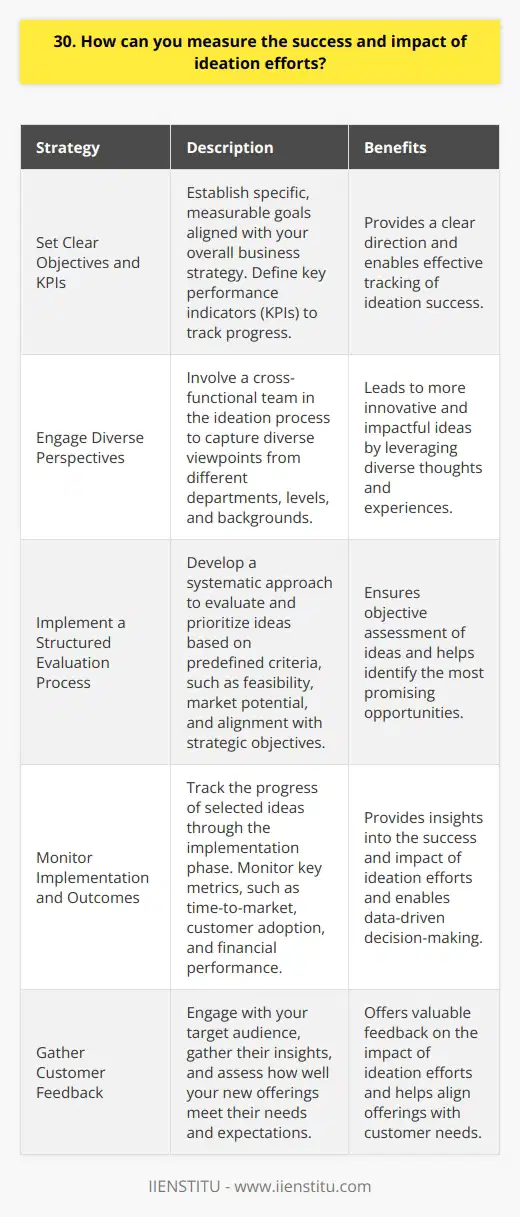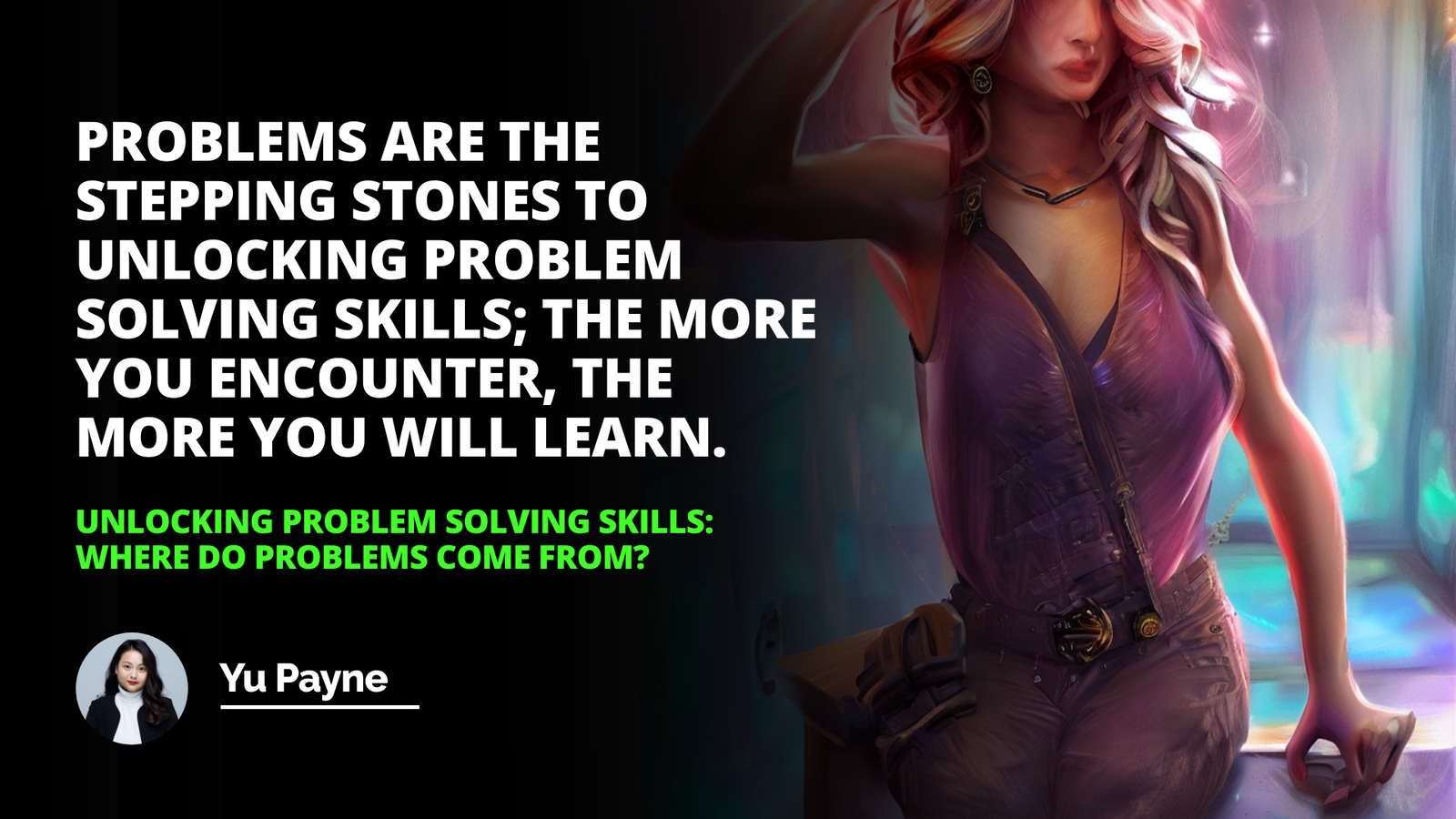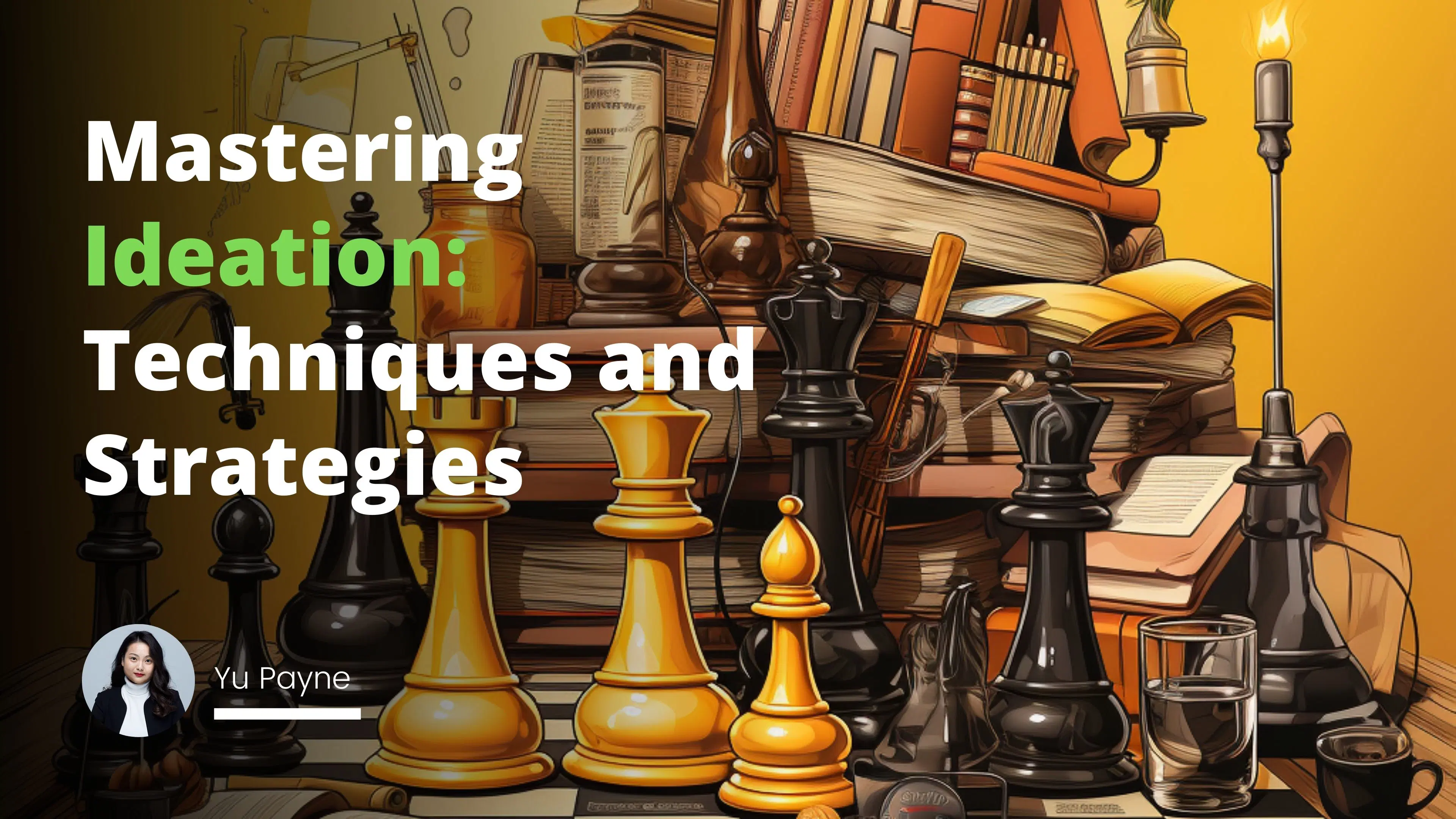
Ever found yourself in a tight spot, grappling with a challenge that feels like trying to fit a square peg in a round hole? We've all been there. And often, the solution isn't just about pushing harder but thinking differently. Enter the world of ideation—a dynamic blend of creativity, innovation, and strategy. In today's rapidly evolving landscape, where problems are as diverse as they come, ideation emerges as the beacon of hope.
By employing a range of ideation techniques, strategies, and methods, one can pave a path through the most intricate mazes of problems. So, let's dive into this exciting realm and explore how ideation is not just a tool, but a mindset, geared towards reimagining solutions and reshaping outcomes.
Whether you're a seasoned strategist or someone just getting started, this guide will walk you through the essentials, the methodologies, and the transformative power of ideation in problem-solving. Ready to ignite that spark? Let’s jump right in!
The Role of Ideation in Effective Problem Solving
Ever heard the saying, "two heads are better than one"? While it's true that collective brainstorming can generate a multitude of ideas, the art of ideation goes far beyond merely tossing thoughts into a proverbial hat. Ideation, in its essence, is the very heart of innovative problem-solving.
Understanding the True Essence of Ideation
At its core, ideation is about breaking boundaries and challenging the status quo. Think of it as your mental toolbox, packed with diverse strategies and methods, each tailored for different challenges. Ideation is not just about quantity, but quality. It's not sufficient to have a hundred ideas; what matters is having that one, transformative solution that strikes gold.
Why Ideation is Indispensable in the Modern Era
In a world marked by constant change and unprecedented challenges, the ability to think outside the box is more valuable than ever. Gone are the days when traditional problem-solving could tackle every issue. As problems evolve, so must our strategies. And this is where ideation comes into play.
With a myriad of ideation techniques at our disposal, from time-tested methods like brainstorming to contemporary strategies like the "Six Thinking Hats", we are equipped to tackle complexities from multifaceted angles. These techniques enable us to dissect a problem, view it through various lenses, and come up with solutions that are not just effective but also revolutionary.
In essence, ideation bridges the gap between conventional thinking and breakthrough innovation. It's a dynamic process that melds the analytical with the creative, ensuring that solutions are not only viable but also visionary. And in today's competitive landscape, where every edge counts, ideation is not just a strategy; it's a necessity.
So, the next time you're faced with a challenge that seems insurmountable, remember that with the right ideation technique in your arsenal, no problem is too big, no challenge too daunting. Embrace ideation, and watch the magic unfold.
Break it Down: What Exactly is Ideation?
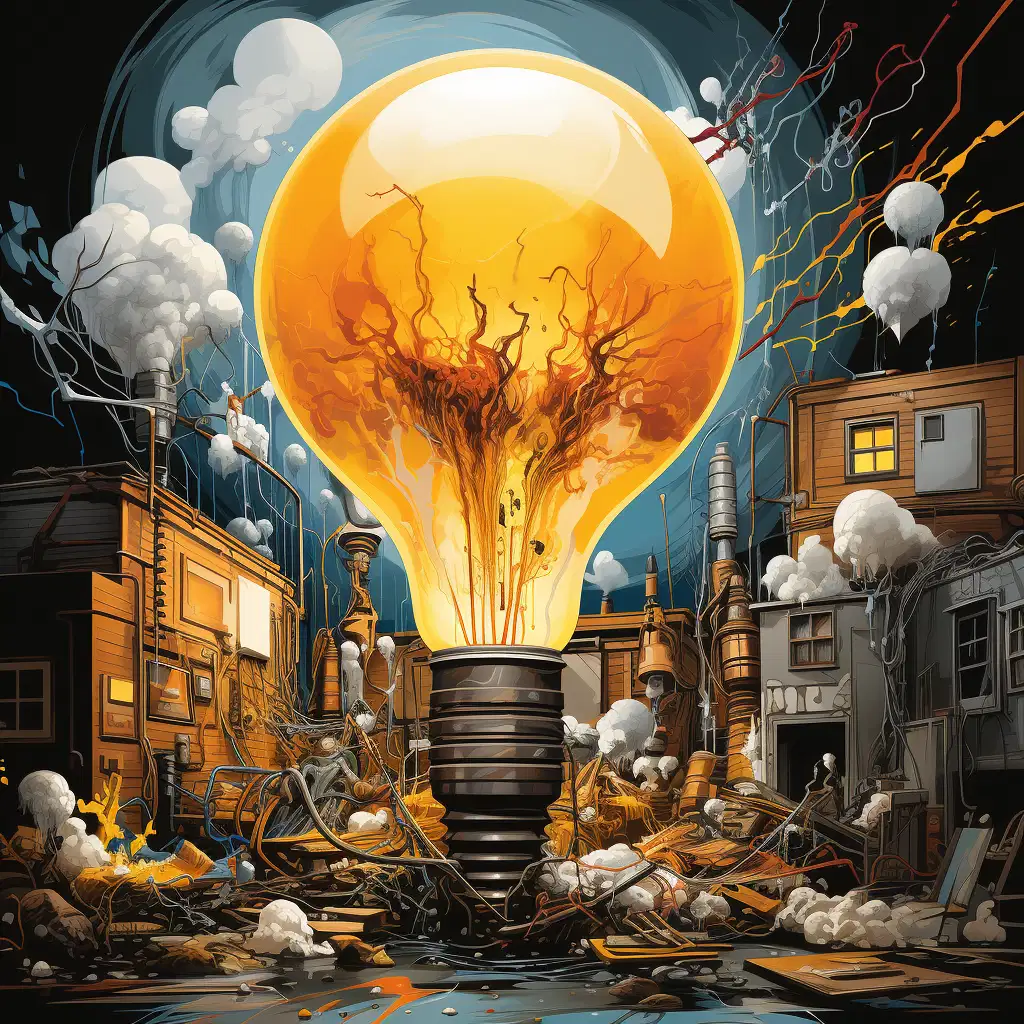
"Think outside the box!" We've all heard it. But how exactly do we achieve this seemingly elusive state of mind? The answer lies in understanding and embracing ideation. Let's delve deeper into this powerful process and understand how it's more than just a buzzword—it's the cornerstone of innovation and creative problem-solving.
Ideation Methods vs. Strategies
When we talk about ideation, two terms often pop up: methods and strategies. But aren't they the same thing? Not quite.
Ideation methods are specific techniques or exercises used to generate new ideas. Think of them as the tools in a craftsman's kit. Whether it's brainstorming sessions, mind mapping, or the SCAMPER technique, these methods provide structured pathways to extract and explore ideas from individuals or teams.
On the other hand, ideation strategies refer to the overarching approach or plan employed to harness these methods. It's the blueprint that guides how these tools (methods) are used. A strategy might involve picking a particular method suitable for the nature of the problem or combining multiple methods to gain varied perspectives.
The Connection Between Ideation and Innovation
Ideation and innovation are two sides of the same coin. While ideation revolves around generating and exploring ideas, innovation is the practical application of these ideas to create value. Without ideation, there's no raw material (ideas) to mold and refine into groundbreaking solutions or products.
Consider ideation as the seed. It's the initial spark, the "Eureka!" moment that has the potential to change the world. Innovation, then, is the process of nurturing this seed, watering it, providing it sunlight, and ensuring it grows into a strong, fruitful tree.
In a rapidly evolving world, where challenges are as unique as they are complex, ideation provides the arsenal of ideas. Innovation then takes the baton, turning these ideas into tangible, impactful solutions. Together, they form a powerhouse duo that drives progress and paves the way for a brighter, smarter future.
In conclusion, understanding ideation is crucial for anyone looking to make waves in their field. It's not just about generating ideas, but about fostering a mindset that continually seeks to challenge, improve, and innovate. And when paired with the practical prowess of innovation, there's truly no limit to what can be achieved. So, are you ready to unleash the power of ideation in your endeavors?
Must-Try Ideation Techniques for Every Innovator

The journey from a fleeting thought to a groundbreaking solution is paved with myriad techniques that channel our creative energies. As innovators, it's vital to familiarize ourselves with these techniques, for they hold the key to unlocking solutions that might otherwise remain obscured. So, roll up those sleeves and let's dive into the treasure trove of ideation techniques every innovator should have in their repertoire!
Brainstorming: The Age-Old Classic
Ah, brainstorming! The OG of ideation techniques. It's simple: gather a group, present a challenge, and let ideas flow freely. The beauty of brainstorming lies in its collective energy. As participants bounce ideas off each other, it creates a synergy where one idea fuels another, leading to a cascade of possibilities. The trick? No judgment. Every idea, no matter how outlandish, has a seat at the table.
Mind Mapping: Visualization at its Finest
Some of us are visual thinkers, and for us, mind mapping is a godsend. Starting with a central idea, this technique involves creating branches that represent related thoughts or sub-ideas. It's like watching a tree grow in real-time, where each branch leads to another, offering a visual representation of the ideation process. The result? A comprehensive map that lays out all facets of a problem, making connections clearer and solutions more apparent.
Role-Playing: Stepping into Others' Shoes
It's one thing to view a problem from your perspective and another to step into someone else's shoes. Role-playing offers just that. By adopting different roles or personas, participants can view challenges from multiple angles. It's a fantastic way to unearth pain points, desires, and solutions that might go unnoticed from a singular viewpoint.
SCAMPER: The Art of Asking Questions
If ideation had a Swiss army knife, SCAMPER would be it. This acronym stands for Substitute, Combine, Adapt, Modify, Put to another use, Eliminate, and Reverse. Each term represents a question that prompts you to think about the problem or idea differently. For instance, "Can I adapt this?" or "What can I eliminate?". SCAMPER pushes you to dissect, reimagine, and reconstruct ideas, often leading to surprising innovations.
The "Six Thinking Hats" Method: Diverse Perspectives
Devised by Edward de Bono, this technique involves donning six metaphorical hats, each representing a different type of thinking—facts (white), emotions (red), skepticism (black), positivity (yellow), creativity (green), and process (blue). By sequentially switching hats, teams can view problems from varied perspectives, ensuring a holistic approach to ideation.
In the vibrant world of ideation, these techniques are just the tip of the iceberg. Yet, they serve as invaluable tools for every innovator, from the budding entrepreneur to the seasoned strategist. By mastering these methods, we not only enrich our ideation arsenal but also equip ourselves to navigate the winding roads of innovation with flair and finesse. So, which technique will you try out next?
How to Choose the Right Ideation Strategy for Your Situation

Choosing the ideal ideation strategy can feel a lot like picking the right outfit for an occasion. A beach party requires different attire than a business meeting, right? Similarly, distinct problems call for varied ideation strategies. Navigating this maze might seem daunting, but with a bit of insight and direction, you can zero in on the perfect strategy tailored for your challenge. So, how do you make this critical choice? Let's dive in!
Recognizing the Nature of the Problem
Like a doctor diagnosing an ailment, the first step is to recognize and understand the nature of the problem. Is it a creative challenge, a logistical one, or perhaps a mix of both? Is it a short-term hurdle or a long-standing issue?
Start by dissecting the problem into its core components. This can involve a SWOT analysis (examining Strengths, Weaknesses, Opportunities, Threats) or a 5 Whys technique (asking "why?" five times to uncover the root cause). By grasping the crux of the challenge, you'll have a clearer perspective on which ideation strategy will be the most effective.
Adapting Your Ideation Technique to the Context
Every situation, project, or challenge has its unique context. A startup brainstorming product ideas operates in a different realm than a multinational corporation strategizing global expansion. Thus, the context dictates the ideation technique.
For fast-paced, dynamic challenges, quick-fire methods like brainstorming or the "Six Thinking Hats" might be apt. For deeper, more intricate issues, techniques like SCAMPER or role-playing could offer the depth and breadth required. Always align your technique with the context, ensuring it complements the environment, stakeholders, and goals.
Ensuring Team Synergy with Chosen Strategies
Ideation is rarely a solitary exercise. It thrives on collaboration. Hence, ensuring that your team is on board and synergized with the chosen strategy is paramount. This involves:
Training & Familiarity: Before diving into a session, ensure the team understands the chosen method. A brief workshop or demo can work wonders.
Feedback Loop: Post-session, gather feedback. Was the strategy effective? Did team members feel comfortable and engaged?
Flexibility: Be prepared to pivot. If a strategy isn't resonating with the team or producing desired outcomes, be open to trying another approach.
Remember, a team that's in sync with the ideation strategy will inherently produce richer, more diverse ideas.
Beyond Techniques: Cultivating an Ideation Mindset
Tools and techniques are the hands and feet of ideation. However, the heart and soul lie in cultivating the right mindset. It's the difference between having a fully-equipped kitchen and being a master chef. While techniques provide a structured path to generate ideas, the mindset dictates how far and wide you tread on this path. Let’s delve deeper into the nuances of nurturing an ideation mindset and the elements that define it.
The Importance of a Conducive Environment
Imagine trying to pen a novel in the midst of a bustling marketplace. Difficult, right? The same applies to ideation. The environment plays a pivotal role. But a conducive environment isn't just about physical spaces filled with bean bags, sticky notes, or whiteboards. It's about creating a psychological space where creativity isn't just welcomed—it's celebrated.
Safe Spaces: Foster environments where team members feel safe to voice even the most unconventional ideas without the fear of judgment.
Stimulating Surroundings: Elements like natural light, plants, or even particular colors can boost creativity and cognitive function.
Break Boundaries: Occasionally stepping out of the usual settings—like holding brainstorming sessions outdoors—can ignite fresh perspectives.
Fostering a Culture of Open-mindedness
Open-mindedness is the lifeblood of ideation. When minds are open, ideas flow unbridled. It's crucial to cultivate a culture where 'different' isn't shunned but embraced.
Avoid the "That Won't Work" Mentality: While not every idea will be a home run, instantly shutting down suggestions curtails creative thinking.
Diverse Teams: Encourage diversity. Different backgrounds, experiences, and perspectives breed richer, more varied ideas.
Celebrate Failures: This might sound counterintuitive, but celebrating failed ideas can bolster risk-taking and out-of-the-box thinking.
Continuous Learning and Adaptability
In the realm of ideation, stagnation is the true antagonist. The world changes, problems evolve, and so should our ideation approaches.
Stay Curious: Encourage a mindset of perpetual curiosity. Ask questions, seek answers, and never stop learning.
Training & Workshops: Regularly update the team with new ideation techniques or methodologies. Knowledge is the fuel for the ideation engine.
Embrace Change: Being adaptable means recognizing when to pivot, when to persevere, and when to go back to the drawing board.
Unlocking the Power of Ideation: It's More Than Just Techniques
As we've traversed the intricate landscape of ideation, one thing stands clear: it's a harmonious blend of techniques, strategies, and most importantly, mindset. While tools and methods serve as guiding stars, the true essence of ideation lies in fostering a culture that breathes creativity. It's about setting the stage for unbridled imagination, ensuring everyone feels empowered to voice their ideas, and maintaining an unquenchable thirst for learning and adaptability.
In this dynamic world where challenges are manifold and ever-evolving, merely relying on techniques won't cut it. It's the mindset, the ethos of ideation, that truly makes the difference. From creating safe spaces to embracing a culture of open-mindedness and continuous learning, the journey of ideation is as much about the heart and soul as it is about methods.
So, as you stand on the cusp of your next innovation challenge, remember: techniques are the keys, but it's the mindset that unlocks the door to groundbreaking solutions. Embrace this holistic approach, and watch your ideation efforts soar to unprecedented heights. Ready to change the world, one idea at a time?
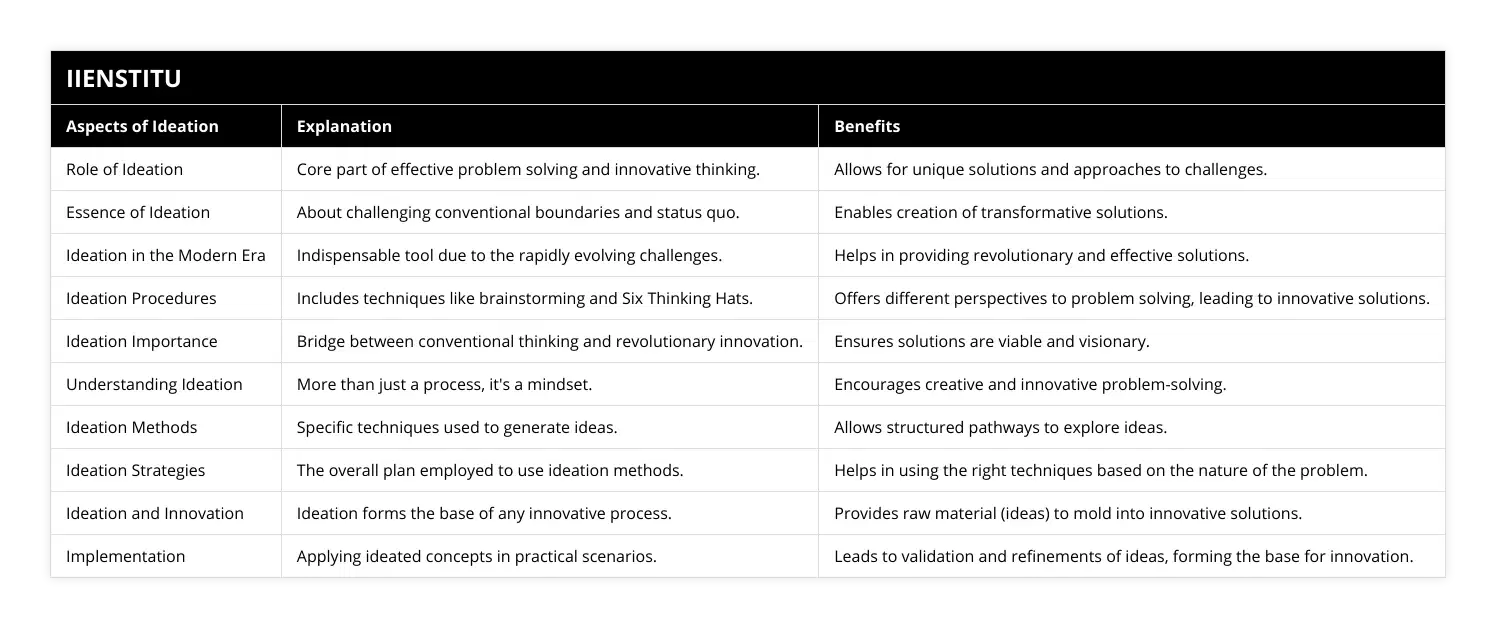
Frequently Asked Questions
1. What are the key elements of effective ideation?
Effective ideation involves several key elements that work together to generate innovative and impactful ideas.
Diverse Perspectives
I've found that bringing together people with different backgrounds and experiences leads to more creative ideas. Last year, our marketing team collaborated with the engineering department on a new product launch. The diverse perspectives helped us come up with a truly unique campaign that resonated with customers.
Clear Problem Definition
Before brainstorming, it's crucial to clearly define the problem or opportunity you're addressing. When I worked on improving our customer support process, we spent time upfront clarifying our goals and challenges. This focus helped us generate targeted solutions.
Safe and Open Environment
Effective ideation requires a safe space where everyone feels comfortable sharing their thoughts without fear of judgment. I remember a brainstorming session where our manager emphasized that all ideas were welcome. This encouragement led to some of our most innovative concepts.
Structured Techniques
Applying structured ideation techniques can help stimulate creative thinking. I find mind mapping particularly useful for exploring different aspects of a problem and uncovering new connections.
Iteration and Refinement
Initial ideas are rarely perfect. Effective ideation involves iterating and building upon concepts. In my experience, some of the best ideas emerge when we combine and refine multiple suggestions.
By fostering diverse perspectives, providing a safe environment, and using structured techniques, you can drive effective ideation and uncover groundbreaking solutions.
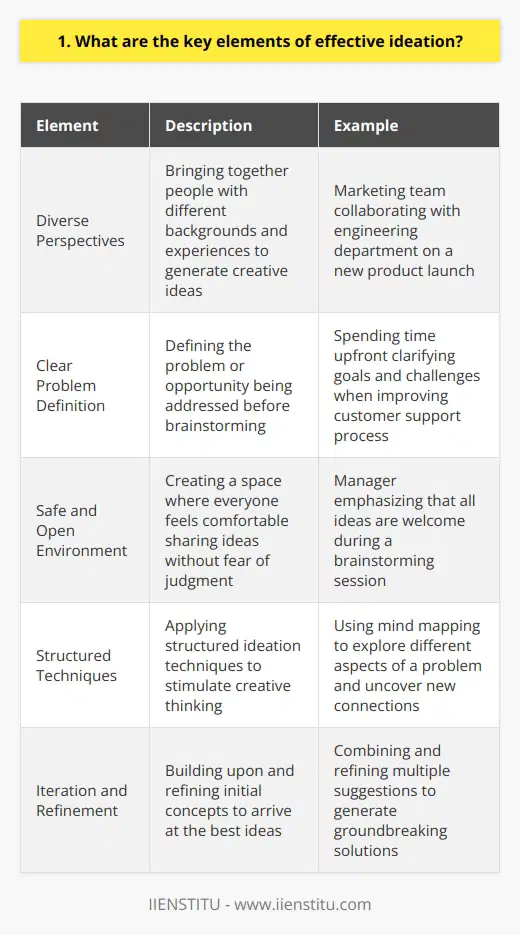
2. How can one improve their ideation skills?
Improving ideation skills is essential for generating novel and innovative solutions in any field. Here are some strategies I've found effective:
Cultivate curiosity
Constantly seek out new information and perspectives. Read widely, attend conferences, and engage with diverse people. This exposure sparks fresh ideas and connections.
Practice brainstorming
Regularly set aside time for unstructured brainstorming sessions. Jot down any ideas that come to mind, no matter how outlandish. Quantity over quality is key here.
Embrace constraints
I find that having some limits actually boosts creativity. Try ideating within a specific time frame or using limited resources. The constraints force you to think differently.
Reframe the problem
When I'm stuck, I step back and look at the issue from new angles. Changing my perspective frequently leads to breakthroughs. Asking "How would X approach this?" helps.
Collaborate with others
Bouncing ideas off colleagues or friends can lead to exciting new concepts. Their unique viewpoints may spark something you hadn't considered. Brainstorming together is powerful.
Prototype and test
Once you have promising ideas, create quick prototypes to test them out. Seeing something tangible makes it easier to refine or pivot if needed. Iteration is invaluable.
With practice, I've found my ideation abilities growing stronger. The key is consistent effort, openness to possibilities, and a willingness to explore. Improving this skill pays dividends in innovation and problem-solving.
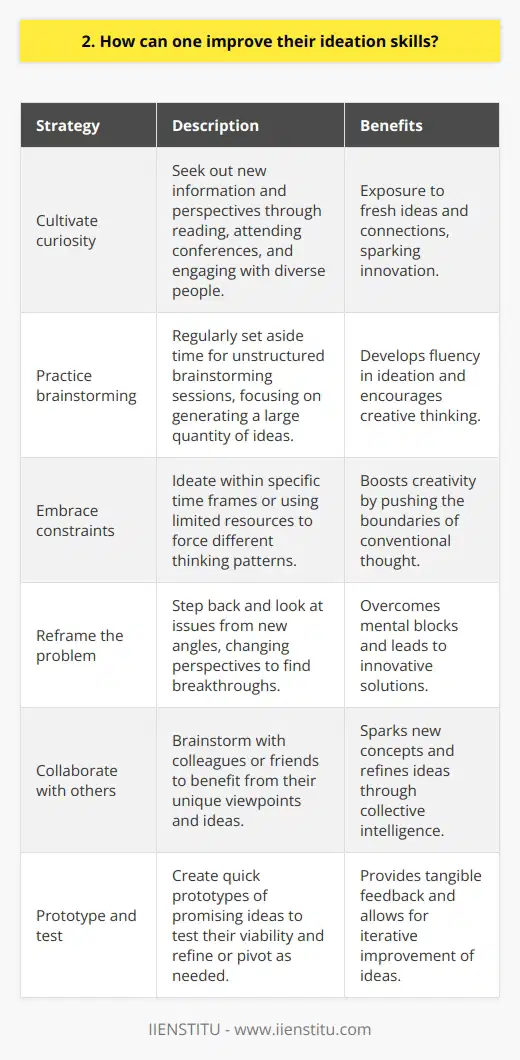
3. What are some common ideation techniques used in brainstorming sessions?
When it comes to brainstorming sessions, there are several common ideation techniques that can help generate creative ideas.
Mind Mapping
I've found mind mapping to be an incredibly effective way to visually organize thoughts and ideas. You start with a central topic and then branch out with related subtopics and ideas. It's a great way to see connections and explore different paths.
Reverse Brainstorming
Instead of trying to solve a problem directly, reverse brainstorming involves looking at ways to cause the problem. By examining the opposite of what you want to achieve, you can gain insights into potential solutions. I remember a time when my team used this technique to tackle a particularly challenging project, and it led us to some really innovative ideas.
SCAMPER Technique
SCAMPER is an acronym that stands for Substitute, Combine, Adapt, Modify, Put to another use, Eliminate, and Reverse. It's a helpful framework for approaching a problem from different angles. I like to go through each letter and ask myself questions to spark new ideas.
Random Word Association
This technique involves choosing a random word and then brainstorming ideas related to that word in the context of your problem. It can lead to some unexpected and creative connections. I once participated in a session where we randomly selected the word "elephant," and it led to a discussion about memory and long-term planning that proved valuable for our project.
These are just a few examples of ideation techniques that can be used in brainstorming sessions. The key is to keep an open mind, encourage participation, and embrace the creative process. With the right techniques and a collaborative spirit, you can generate innovative solutions to even the most challenging problems.
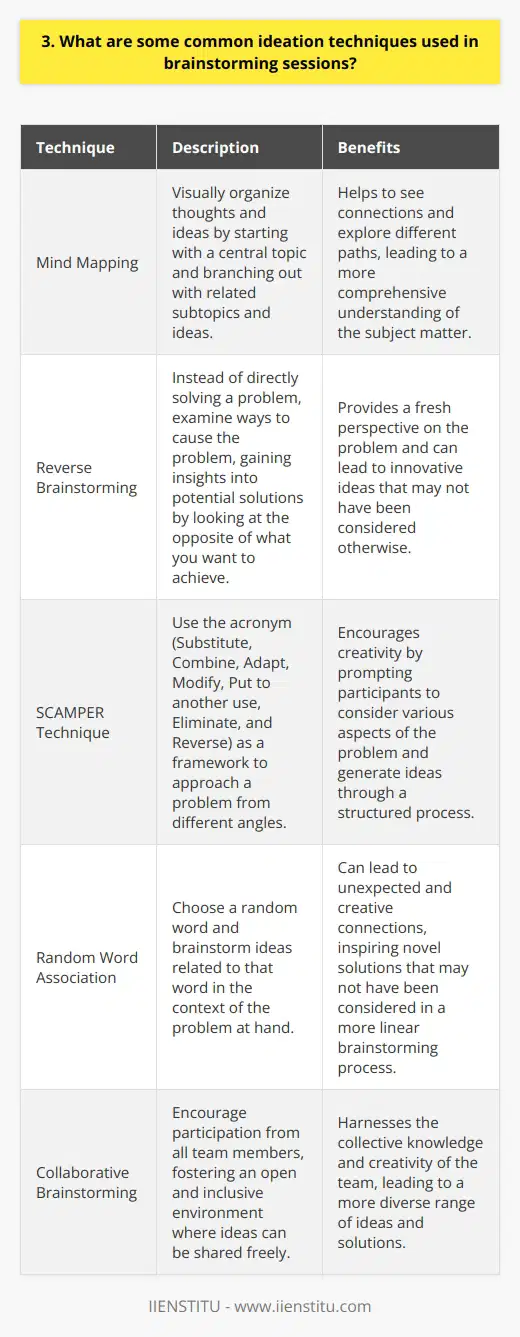
4. How do you encourage creative thinking during ideation?
When it comes to encouraging creative thinking during ideation, I believe in fostering an open and collaborative environment. I've found that setting clear expectations and providing a safe space for sharing ideas is crucial. Here are a few strategies I use:
Create a Judgment-Free Zone
I make it clear that all ideas are welcome, no matter how unconventional they may seem. When team members feel comfortable sharing their thoughts without fear of criticism, they're more likely to think outside the box.
Encourage Diverse Perspectives
I actively seek out team members with different backgrounds and skill sets to participate in ideation sessions. Bringing together a mix of viewpoints can lead to unexpected and innovative solutions.
Use Brainstorming Techniques
From mind mapping to word association games, I employ various brainstorming techniques to get the creative juices flowing. These exercises help break mental barriers and stimulate new ways of thinking.
Embrace Failure
I remind my team that not every idea will be a winner, and that's okay. Encouraging experimentation and risk-taking can lead to breakthrough concepts that may not have been discovered otherwise.
Celebrate Successes
When a creative idea leads to a successful outcome, I make sure to recognize and celebrate the team's efforts. Acknowledging innovative thinking reinforces the value of creativity and motivates everyone to keep pushing boundaries.
At the end of the day, nurturing a culture of creativity requires consistent effort and leadership by example. By valuing diverse opinions, providing opportunities for exploration, and rewarding innovative thinking, I strive to create an environment where creativity can thrive.
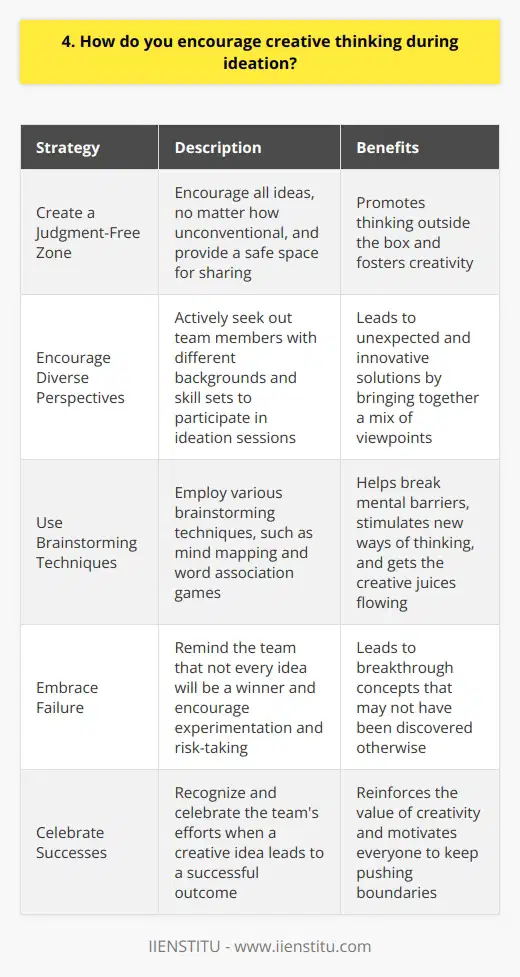
5. What role does collaboration play in the ideation process?
Collaboration is a critical component of the ideation process. It allows individuals with diverse perspectives and skill sets to come together and generate innovative solutions to complex problems.
Diversity of Thought
When people from different backgrounds collaborate, they bring unique experiences and insights to the table. This diversity of thought can lead to breakthrough ideas that may not have been possible with a homogeneous group.
Example from My Experience
I remember working on a project with a cross-functional team at my previous company. We were tasked with developing a new product feature, and initially, we struggled to come up with viable solutions. However, as we began to share our individual perspectives and experiences, we started to see the problem from different angles. Our collective knowledge and creativity led us to develop a feature that exceeded our clients' expectations and boosted user engagement.
Building on Each Other's Ideas
Collaboration allows team members to build upon each other's ideas, creating a synergistic effect. One person's suggestion can spark inspiration in another, leading to a chain reaction of innovative thoughts.
The Power of "Yes, and..."
In improv comedy, there's a principle called "Yes, and..." which encourages performers to accept and build upon their partner's ideas. I believe this concept translates well to the ideation process. By embracing and expanding on each other's suggestions, teams can create something greater than the sum of its parts.
Overcoming Blind Spots
We all have blind spots – areas where our knowledge or perspective is limited. Collaboration helps to fill in those gaps by leveraging the expertise of others.
Learning from My Colleagues
I've worked on projects where I felt out of my depth, but my colleagues were there to support me. Their knowledge and guidance helped me to overcome challenges and contribute meaningfully to the ideation process. In turn, I was able to share my own expertise in areas where they had blind spots.
In conclusion, collaboration is essential for generating innovative ideas and solving complex problems. By bringing together diverse perspectives, building on each other's ideas, and overcoming individual blind spots, teams can achieve remarkable results.
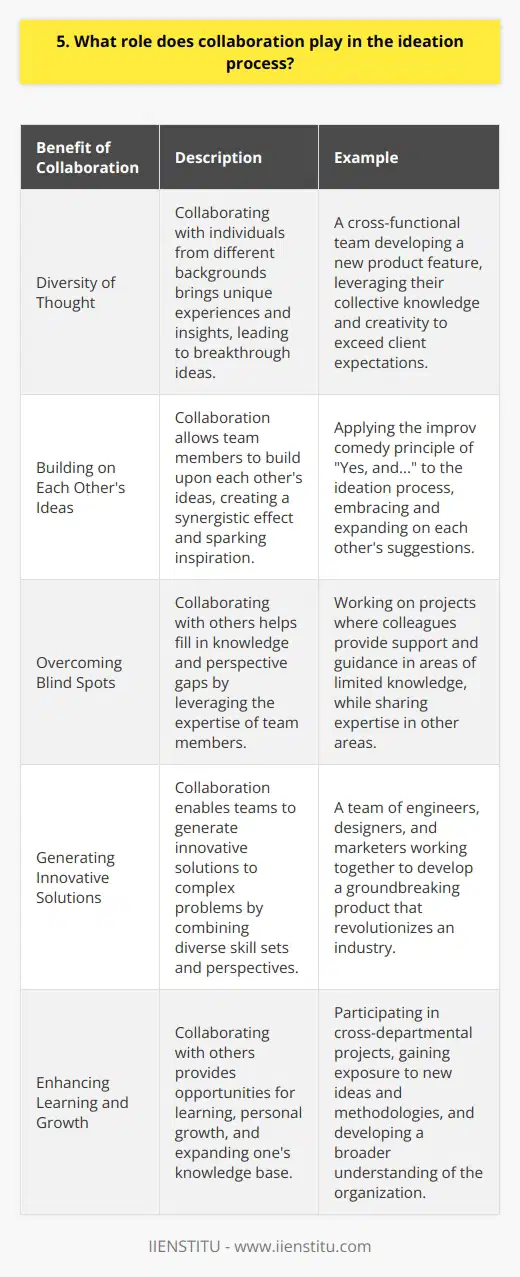
6. How can you ensure that ideation sessions remain focused and productive?
I've found that setting clear goals and expectations at the beginning of ideation sessions is crucial. When everyone knows the desired outcome, it's easier to stay on track.
Assign a Facilitator
Having a designated facilitator can make a big difference in keeping the discussion focused and productive. They can gently redirect tangents and ensure equal participation from all members.
Use a Structured Format
Following a specific ideation format, like brainstorming followed by grouping and prioritizing ideas, provides helpful structure. It prevents the session from devolving into an unproductive free-for-all.
Take Breaks
Sometimes the best way to maintain focus is to step away for a few minutes. Short breaks can help people recharge and return with fresh energy and ideas.
Capture Ideas Visually
I'm a big fan of using whiteboards, sticky notes, or mind maps to document ideas as they emerge. Having a visual record keeps the discussion grounded and makes it easier to identify patterns and themes.
Follow Up
The work isn't done when the ideation session ends. Sending out a summary with next steps and assigning action items maintains momentum and accountability.
Ultimately, productive ideation is about finding the right balance of creativity and structure. With thoughtful planning and facilitation, you can harness your team's best ideas while keeping things on track.
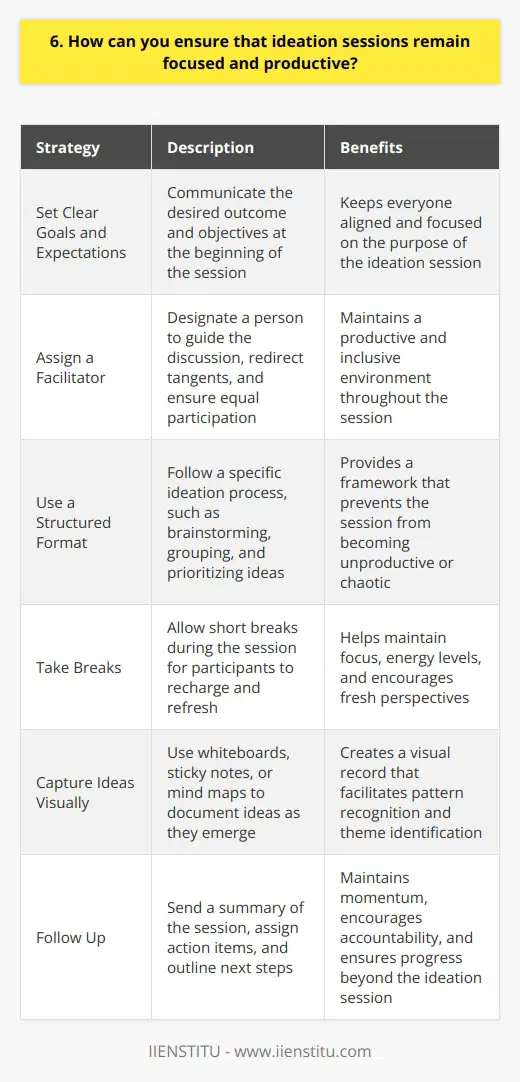
7. What are some ways to overcome creative blocks during ideation?
When faced with creative blocks during ideation, I find that taking a break and stepping away from the problem can be incredibly helpful. Sometimes, my best ideas come to me when I'm not actively trying to think of a solution, like when I'm out for a walk or taking a shower.
Change Your Environment
Another strategy that works well for me is to change my environment. If I've been brainstorming in my office for hours, I'll switch things up and move to a coffee shop or park. The new surroundings can stimulate my mind and help me approach the problem from a different angle.
Collaborate with Others
Collaborating with others is also a great way to overcome creative blocks. Bouncing ideas off of colleagues or friends can lead to new insights and perspectives that I might not have considered on my own. Even if their suggestions don't directly solve the problem, they can often spark new ideas that I can build upon.
Embrace Constraints
Paradoxically, I've found that embracing constraints can actually boost my creativity. When I have too many options, it can be overwhelming and lead to analysis paralysis. But when I deliberately limit myself, whether it's by setting a time limit or using a specific set of tools, it forces me to be more resourceful and think outside the box.
Trust the Process
Finally, I think it's important to trust the creative process and not put too much pressure on myself to come up with the perfect idea right away. Some of my best work has come from ideas that I initially dismissed as silly or impractical. By allowing myself to explore and iterate, I can often arrive at a solution that I'm really excited about.
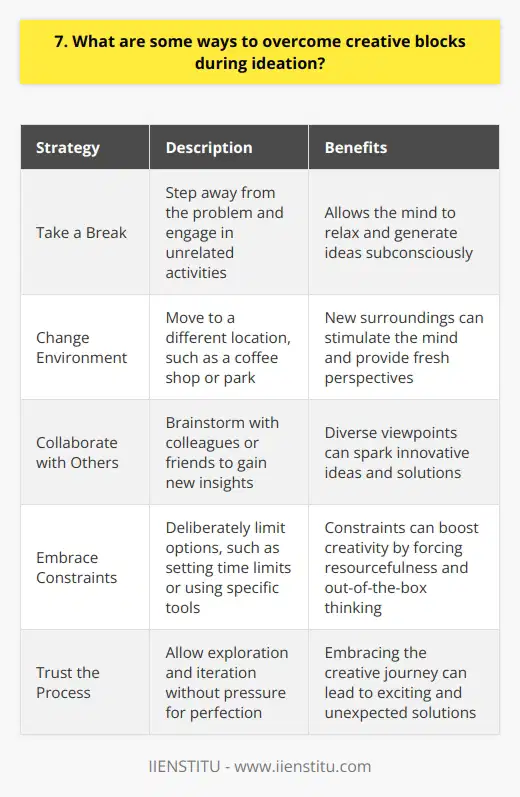
8. How do you evaluate and prioritize ideas generated during ideation?
When evaluating and prioritizing ideas during ideation, I first consider how well each idea aligns with the project goals. I ask myself, "Will this idea effectively solve the problem or meet the need we've identified?" If the answer is yes, it moves higher on my priority list.
Next, I assess the feasibility of each idea. Some questions I consider:
Feasibility Considerations
I also think about the potential impact of each idea. Will it deliver significant value to our users or customers? Does it have the potential to differentiate us from competitors? High-impact ideas get prioritized.
Balancing Creativity and Practicality
While I believe it's important to think big and be creative during ideation, I also try to balance that with a dose of practicality. An idea might sound amazing in theory, but if it's not actionable or aligned with our strategies, it may need to be set aside, at least for the time being.
Ultimately, I rely on a combination of strategic alignment, feasibility assessment, and impact analysis to evaluate and prioritize ideas. This helps ensure we're focusing our efforts on the concepts that have the greatest potential to drive results while still being realistic to execute.
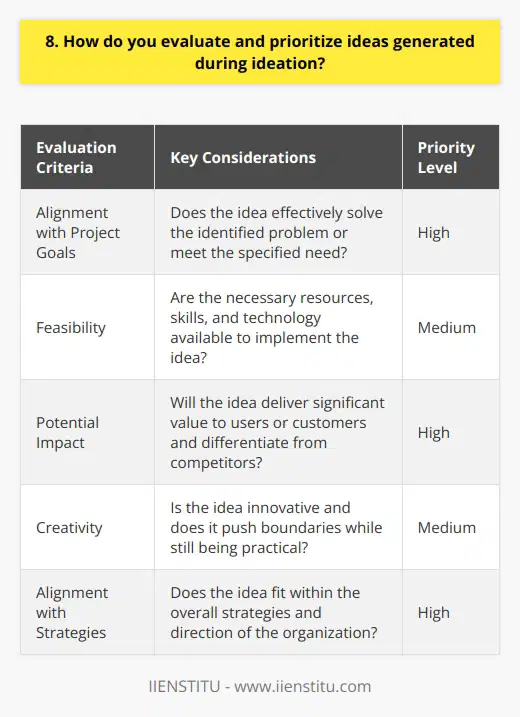
9. What are the benefits of using mind mapping in ideation?
Mind mapping is a powerful tool for ideation that offers several benefits. It helps to organize thoughts and ideas in a visual way, making it easier to see connections and relationships between different concepts. Mind mapping also encourages creativity by allowing the brain to freely associate and generate new ideas without the constraints of linear thinking.
Boost Productivity
Using mind maps can significantly boost productivity during brainstorming sessions. Instead of getting stuck on one idea, mind mapping enables you to quickly jot down multiple ideas and explore various possibilities. This way, you can generate a large quantity of ideas in a short amount of time, increasing the chances of finding innovative solutions.
Enhance Memory Retention
I find that mind mapping enhances memory retention compared to traditional note-taking methods. The visual nature of mind maps, with their colorful branches and images, helps to create strong mental associations. When I review my mind maps later, I can easily recall the key points and ideas, as the visual cues trigger my memory effectively.
Collaborative Ideation
Mind mapping is a fantastic tool for collaborative ideation. When working with a team, mind maps allow everyone to contribute their ideas simultaneously. Each person can add their thoughts to different branches, building upon each other's ideas. This collaborative approach fosters a sense of involvement and ownership, leading to more diverse and creative solutions.
Identify Patterns and Connections
One of the greatest advantages of mind mapping is its ability to reveal patterns and connections between seemingly unrelated ideas. As you expand your mind map, you may discover surprising links and relationships. These insights can spark new ideas and lead to innovative breakthroughs that you might have missed using linear brainstorming methods.
In my experience, mind mapping has been an invaluable tool for ideation. It has helped me to think more creatively, generate a wealth of ideas quickly, and identify unique connections. By leveraging the power of mind mapping, you can take your ideation process to new heights and achieve remarkable results.

10. How can you create an environment that fosters innovation and ideation?
To create an environment that fosters innovation and ideation, I believe in leading by example. In my previous role as a project manager, I made a conscious effort to encourage open communication and collaboration among team members.
Encouraging Brainstorming Sessions
One strategy I found effective was organizing regular brainstorming sessions. These sessions provided a safe space for everyone to share their ideas without fear of judgment. We celebrated creativity and out-of-the-box thinking, which helped generate unique solutions to complex problems.
Promoting a Culture of Experimentation
I also promoted a culture of experimentation within the team. We embraced the concept of "failing fast" and learning from our mistakes. By allowing room for trial and error, we fostered a mindset of continuous improvement and innovation.
Recognizing and Rewarding Innovation
Another important aspect was recognizing and rewarding innovative ideas. When team members came up with creative solutions or process improvements, we made sure to acknowledge their contributions publicly. This not only boosted morale but also encouraged others to think innovatively.
Providing Resources and Support
Lastly, I believe in providing the necessary resources and support to bring ideas to life. Whether it was allocating budget for prototyping or offering training opportunities, I strived to empower my team to turn their ideas into reality.
By fostering open communication, encouraging experimentation, recognizing innovation, and providing support, I aim to create an environment where innovation thrives. I'm excited to bring this approach to your organization and contribute to a culture of ideation and continuous improvement.
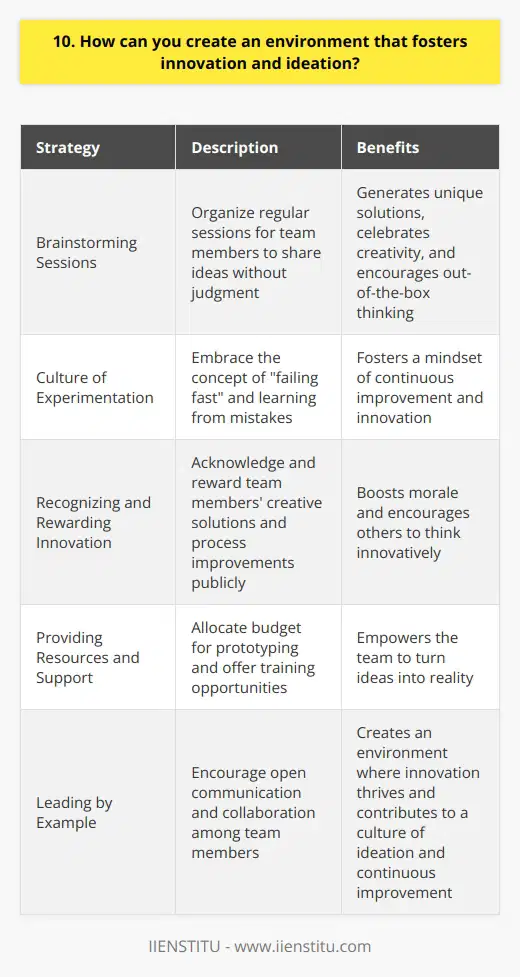
11. What are some techniques for generating ideas individually?
When it comes to generating ideas individually, there are several techniques that I find effective. Mind mapping is one of my favorites. I start by writing the main topic in the center of a blank page and then branch out with related subtopics and ideas. It helps me visualize connections and explore different angles.
Freewriting
Another technique I often use is freewriting. I set a timer for 10-15 minutes and just write whatever comes to mind without worrying about grammar or structure. It's a great way to tap into my creativity and overcome mental blocks. After freewriting, I go back and highlight the most promising ideas to develop further.
Asking Questions
Asking "what if" questions is another approach I take. What if the problem was approached from a different perspective? What if we had unlimited resources? These hypothetical questions help me think outside the box and consider new possibilities.
Drawing Inspiration
I also find inspiration by exposing myself to diverse sources of information. Reading books, watching TED talks, and exploring art and nature often spark new ideas for me. I jot down thoughts in a notebook or snap photos to capture moments of insight.
Remember, generating ideas is a skill that can be developed with practice. Don't be afraid to experiment with different techniques and find what works best for you. Trust your intuition and let your creativity flow!
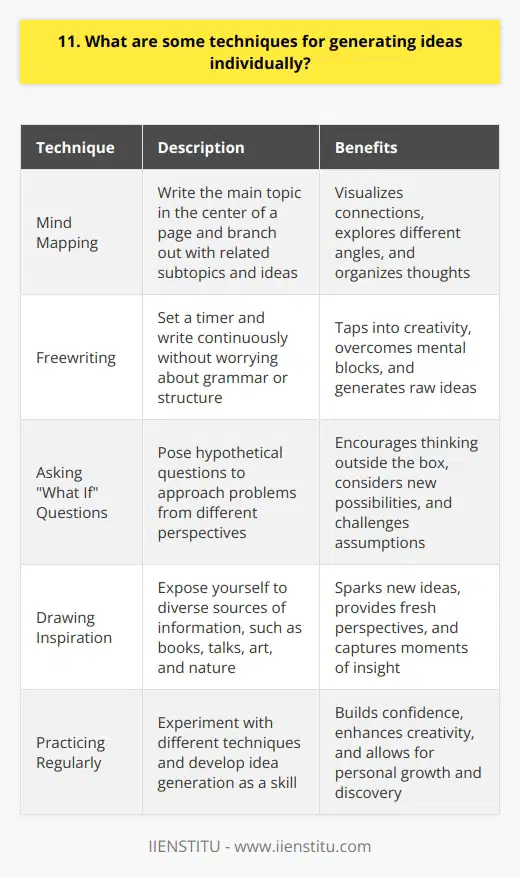
12. How do you facilitate ideation sessions with remote teams?
As a team leader, I have extensive experience facilitating ideation sessions with remote teams. Here are some strategies I use to ensure productive and engaging sessions:
Set Clear Goals and Expectations
Before the session, I communicate the objectives and desired outcomes to all participants. This helps everyone come prepared and focused.
Choose the Right Tools
I select collaboration platforms that allow for real-time brainstorming, such as virtual whiteboards and mind mapping software. These tools enable team members to contribute ideas visually and simultaneously.
Encourage Active Participation
To ensure everyone's voice is heard, I use facilitation techniques like round-robin sharing and nominal group technique. I also create a safe space where all ideas are welcomed and valued.
Break into Smaller Groups
When working with larger teams, I often divide participants into breakout rooms for more intimate discussions. This allows for more focused ideation and prevents individuals from getting lost in the crowd.
Maintain Energy and Engagement
To keep the session lively, I incorporate energizers, icebreakers, and short breaks. These activities help combat virtual fatigue and maintain enthusiasm throughout the session.
Capture and Organize Ideas
As ideas flow, I make sure to document them in a structured manner using digital tools. This ensures that all contributions are captured and can be easily accessed for future reference.
By following these strategies, I have successfully led numerous remote ideation sessions that have generated innovative solutions and strengthened team collaboration.
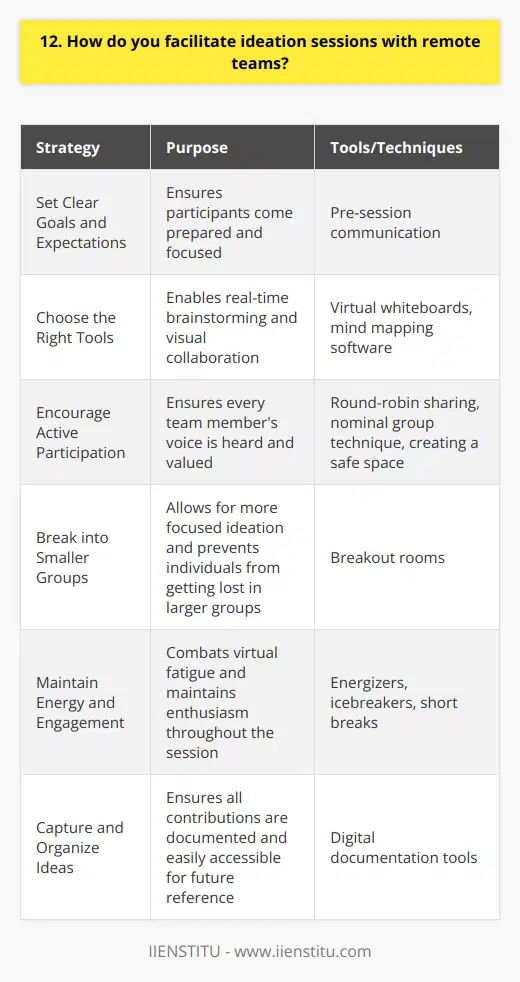
13. What are the advantages of using analogies and metaphors in ideation?
Analogies and metaphors are powerful tools for generating new ideas and innovations. They allow us to make connections between seemingly unrelated concepts, leading to fresh perspectives and insights.
Connecting Disparate Ideas
By comparing two different things, analogies help us see parallels we might otherwise miss. This cross-pollination of ideas from various domains can spark truly original solutions to challenges.
Memorable and Engaging
Metaphors paint vivid mental pictures that stick in our minds. Describing a concept using a metaphor makes it more memorable and engaging for others, increasing buy-in for new initiatives.
Simplifying Complex Concepts
Abstract ideas can be difficult to grasp. Drawing an analogy to something familiar and concrete helps break down complexity, making the concept more accessible and understandable to a wider audience.
Emotional Resonance
I find that metaphors pack an emotional punch. Comparing an initiative to something personally meaningful fosters an emotional connection, motivating teams to passionately pursue audacious goals.
In my experience, some of our company's most inventive products started as metaphorical seeds that blossomed into disruptive innovations. Encouraging this type of imaginative thinking keeps us agile and ahead of the curve.
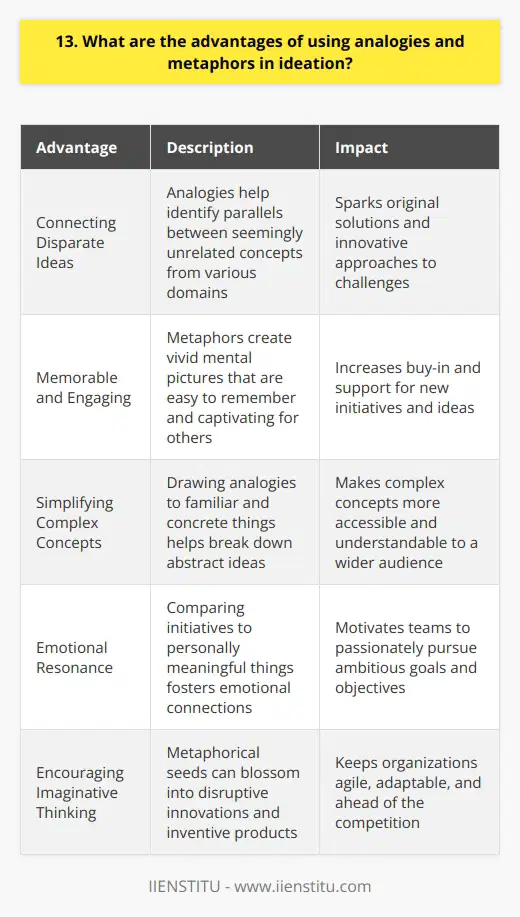
14. How can you encourage participation from all team members during ideation?
As a team leader, I believe in creating an inclusive environment that encourages everyone to share their ideas. One effective strategy I've found is to start brainstorming sessions with an icebreaker activity. This helps team members feel more comfortable and sets a positive tone for collaboration.
Assign pre-work
Before the ideation session, I ask each team member to come prepared with a few initial ideas. This ensures that everyone has something to contribute right from the start. It also gives quieter individuals a chance to gather their thoughts ahead of time.
Use varied facilitation techniques
During the session, I employ different facilitation methods to keep everyone engaged. For example, I might use silent brainstorming, where team members write down ideas independently before sharing. This prevents dominant personalities from overshadowing others.
I also like to break the team into smaller groups for discussions. This makes it easier for everyone to participate actively. Afterward, each group shares their best ideas with the whole team.
Create a safe space
Most importantly, I strive to create a psychologically safe environment where all ideas are welcomed and valued. I emphasize that there are no bad ideas during brainstorming. If someone's suggestion isn't feasible, we build upon it rather than dismissing it outright.
By making space for every voice, I've found that my teams generate more creative and diverse solutions. When everyone feels heard, they're more invested in the ideation process and its outcomes.
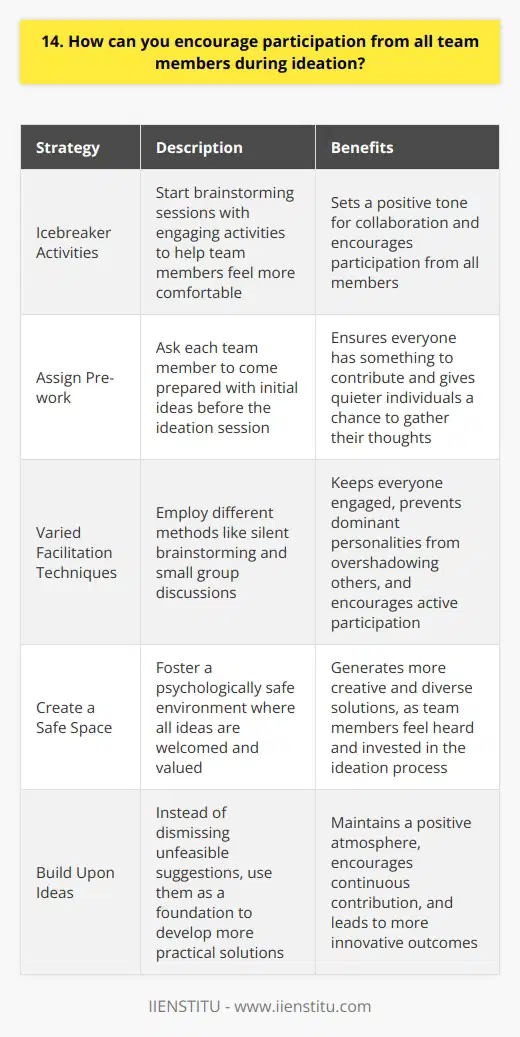
15. What are some strategies for combining and building upon ideas?
Combining and building upon ideas is a valuable skill that can lead to innovative solutions and creative breakthroughs. When faced with a problem or challenge, I find it helpful to start by brainstorming and generating as many ideas as possible, no matter how unconventional they may seem at first.
Collaboration is Key
One of the most effective strategies I've discovered is collaborating with others. By bringing together diverse perspectives and experiences, you can often arrive at ideas that no one person would have thought of alone. I remember a project I worked on last year where my team was stuck on a particularly tricky issue. We decided to hold a brainstorming session and invited colleagues from different departments to join us. The cross-pollination of ideas that resulted was truly remarkable, and we ended up with a solution that none of us had initially considered.
Building on Existing Ideas
Another approach I like to use is building upon existing ideas. Rather than always trying to come up with something completely new, I look for ways to improve or combine ideas that are already out there. This could mean taking an idea from one industry and applying it to another, or finding synergies between seemingly unrelated concepts.
Embracing Failure
Of course, not every idea will be a winner, and that's okay. I believe that embracing failure is an essential part of the creative process. When an idea doesn't pan out, I try to learn from it and use that knowledge to inform my next attempt. It's all about iterating and refining until you hit upon something that works.
At the end of the day, combining and building upon ideas is all about staying curious, open-minded, and willing to take risks. By approaching problems from multiple angles and being unafraid to think outside the box, we can often arrive at solutions that are far more innovative and effective than we ever thought possible.
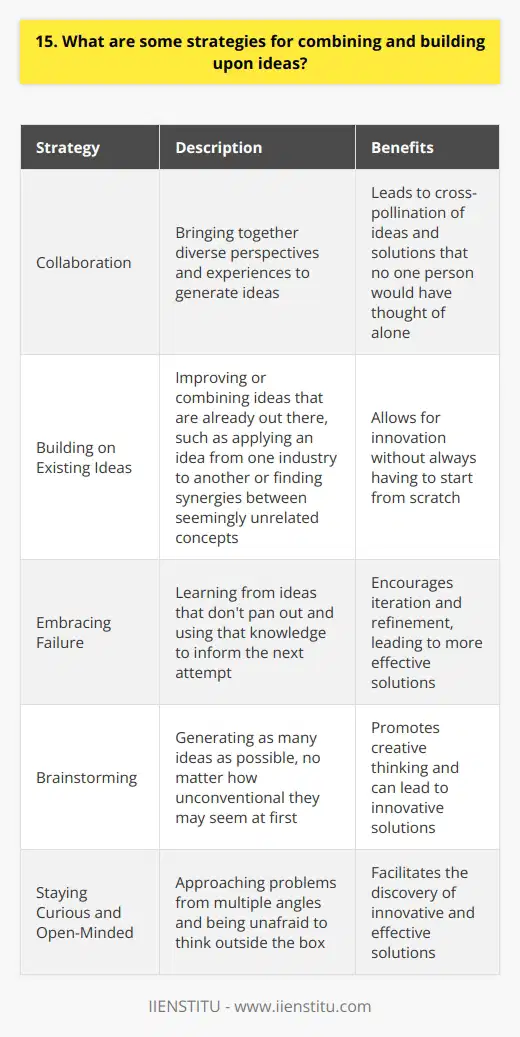
16. How do you manage conflicting ideas during the ideation process?
When faced with conflicting ideas during the ideation process, I believe in fostering open and respectful communication among team members. By encouraging everyone to share their thoughts and perspectives, we can gain a more comprehensive understanding of the issue at hand.
Active Listening
I make a conscious effort to actively listen to each person's ideas without judgment. This creates a safe space where everyone feels heard and valued, promoting a collaborative atmosphere.
Finding Common Ground
Once all ideas are on the table, I try to identify common themes or goals that unite the conflicting perspectives. By focusing on these shared objectives, we can often find a way to bridge the gap between differing opinions.
Compromise and Consensus
In my experience, the best solutions often involve a bit of give and take from all parties involved. I encourage team members to be open to compromise, seeking a middle ground that incorporates elements of various ideas. Through discussion and negotiation, we can usually reach a consensus that everyone can support.
Testing and Iteration
When we're truly stuck between conflicting ideas, I suggest testing both approaches on a small scale. By gathering data and feedback, we can make an informed decision based on real-world results rather than hypotheticals. And if neither option proves optimal, we can iterate and refine our ideas until we find a solution that works.
At the end of the day, managing conflicting ideas is about maintaining an open mind, fostering collaboration, and being willing to adapt. By approaching these situations with empathy and a problem-solving mindset, I believe we can turn conflicts into opportunities for innovation and growth.

17. What are some techniques for generating ideas under time constraints?
When faced with time constraints, I rely on several techniques to generate ideas quickly and effectively:
Brainstorming
I start by jotting down any ideas that come to mind, no matter how unusual they may seem. This free-flow of thoughts often leads to unexpected connections and insights.
Mind Mapping
I create a visual diagram with the main topic at the center and branch out with related ideas. Seeing the relationships between concepts helps me identify promising directions to explore further.
Asking "What If" Questions
I challenge assumptions by asking "What if we approached this differently?" or "What if we combined these ideas?" Turning the problem on its head can reveal innovative solutions.
Drawing Inspiration from Other Fields
Looking to unrelated industries or nature often sparks my creativity. I consider how they solve similar challenges and adapt those strategies to the task at hand.
Collaborating with Others
When possible, I bounce ideas off colleagues or friends. Their fresh perspectives can uncover angles I hadn't considered and build upon my initial concepts.
By utilizing a mix of these techniques, I'm able to rapidly generate a variety of potential ideas to meet tight deadlines. With practice, I've learned to trust my instincts and not get caught up in striving for perfection. The key is to let the creative juices flow and then refine the most promising ideas as time allows.
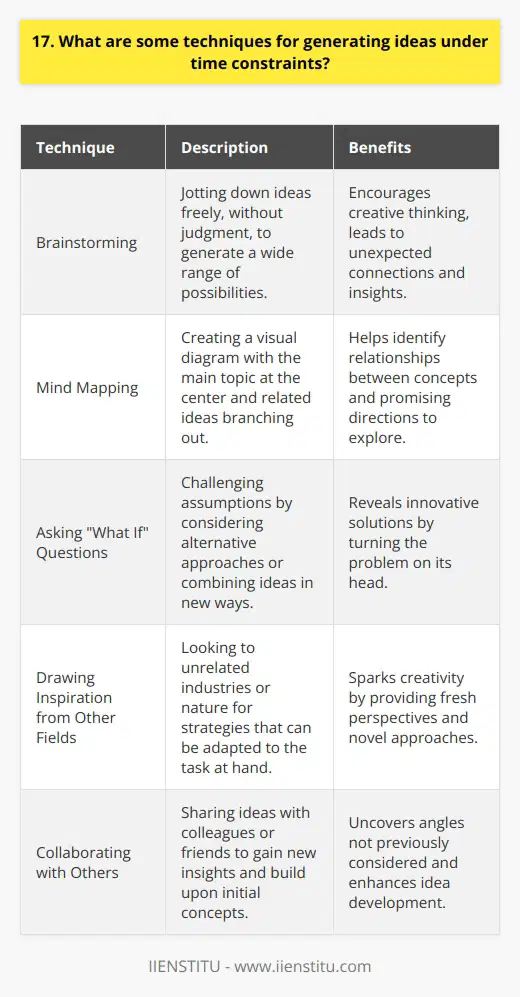
18. How can you use technology to enhance the ideation process?
Technology offers numerous ways to enhance the ideation process and stimulate creative thinking:
Brainstorming Tools
Digital whiteboards like Miro or Mural facilitate collaborative brainstorming sessions, even with remote teams. These platforms allow everyone to contribute ideas simultaneously, making the process more engaging and productive.
Mind Mapping Software
Tools like MindMeister or XMind help visualize connections between ideas and concepts. Creating mind maps digitally makes it easy to rearrange nodes, add images, and share with others for feedback.
Inspiration Boards
Pinterest or Milanote are great for collecting inspiring images, articles, and resources in one place. I find that browsing through my inspiration boards often sparks new ideas or helps me approach problems from a different angle.
Virtual Reality
VR technology can immerse teams in interactive environments that stimulate creative thinking. For example, architects or designers could explore 3D models of their creations, leading to new ideas and improvements.
AI-Powered Idea Generators
Tools like Idea Generator or Coda's Idea Recommender can provide random prompts or suggestions to kickstart brainstorming. While AI-generated ideas may need refinement, they can help overcome creative blocks and inspire new directions.
Online Research
The internet offers a wealth of information and inspiration for ideation. Conducting research on relevant topics, exploring forums or social media discussions, and studying competitors can all spark fresh ideas and insights.
The key is experimenting with different technologies to find what works best for your team and ideation process. By leveraging the right tools strategically, you can enhance creativity, collaboration, and innovation in your work.
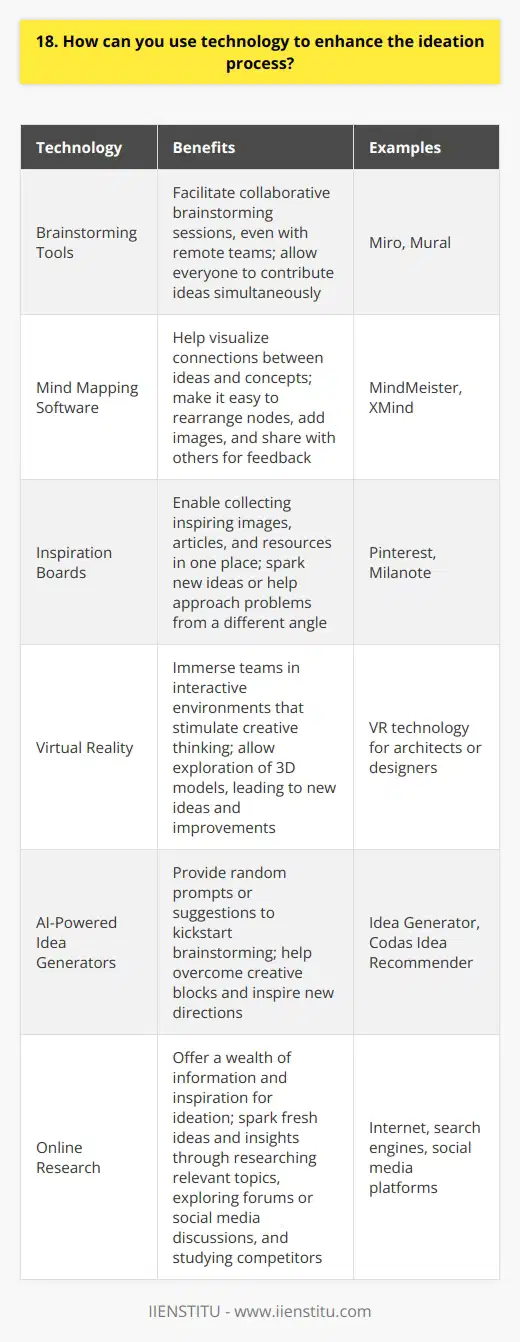
19. What are some methods for generating ideas outside of traditional brainstorming sessions?
When it comes to generating ideas, there are many methods beyond traditional brainstorming sessions. Here are a few techniques I've found effective:
Mind Mapping
Start with a central concept and branch out with related ideas. This visual approach helps connect different thoughts. I like using colorful pens and large paper to make the process more engaging and creative.
Personal Reflection
Take a walk, sit in nature, or find a quiet space to think deeply about the topic. Allowing your mind to wander can lead to unexpected insights. I often come up with my best ideas while hiking in the woods near my home.
Talk It Out
Discuss the subject with a colleague, friend, or family member. Hearing different perspectives can spark new ideas. Some of my most creative solutions have come from casual conversations over coffee or dinner.
Reverse Brainstorming
Instead of thinking about what could work, consider what wouldn't work. This reverse approach can highlight potential issues and inspire fixes. I used this method successfully when developing a new product launch strategy at my previous job.
Research and Adapt
Look at how others have approached similar challenges. Adapt their ideas to suit your specific situation. Reading case studies and industry blogs often gives me a fresh outlook on problems.
The key is being open to inspiration from many sources. Combining methods can lead to truly innovative thinking.
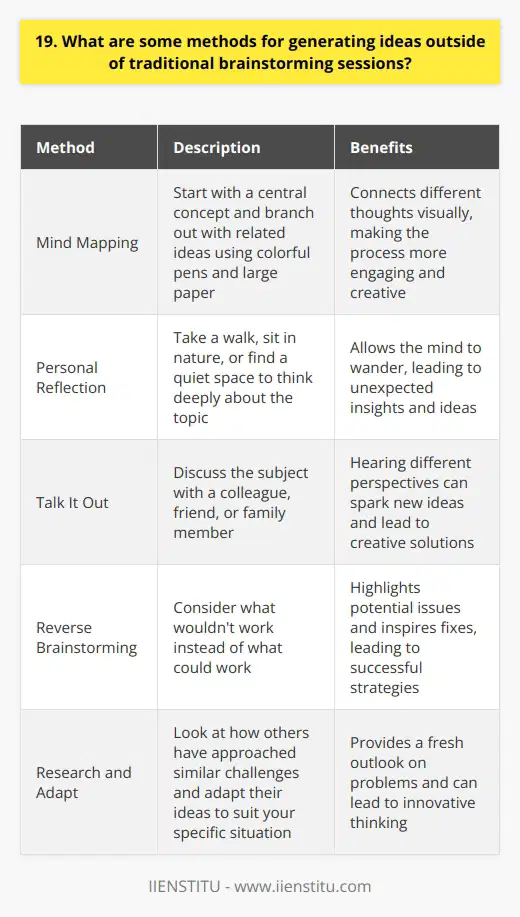
20. How do you ensure that ideation sessions align with project goals and objectives?
Ensuring that ideation sessions align with project goals and objectives is crucial for their success. I have a few strategies that I employ to make sure we stay on track.
Clearly Define Objectives Upfront
Before the ideation session even begins, I make sure to clearly define the project objectives. This helps set the stage and keeps everyone focused on what we're trying to achieve.
Keep the Discussion Focused
During the actual ideation, I act as a facilitator to keep the discussion centered around our goals. If the conversation starts to veer off-topic, I gently steer it back by reminding the group of our objectives.
Ask Guiding Questions
Thoughtful questions can help spur ideas that are relevant to the project. I come prepared with prompts like "How could this idea support our goal of X?" to stimulate targeted brainstorming.
Evaluate Ideas Against Criteria
After generating a bunch of ideas, I have the group assess them against our predefined objectives. We prioritize and refine the concepts that best align with the project needs.
By keeping goals front and center throughout the process, ideation sessions can be highly productive. The key is preparation, facilitation, and always tying things back to the bigger picture.
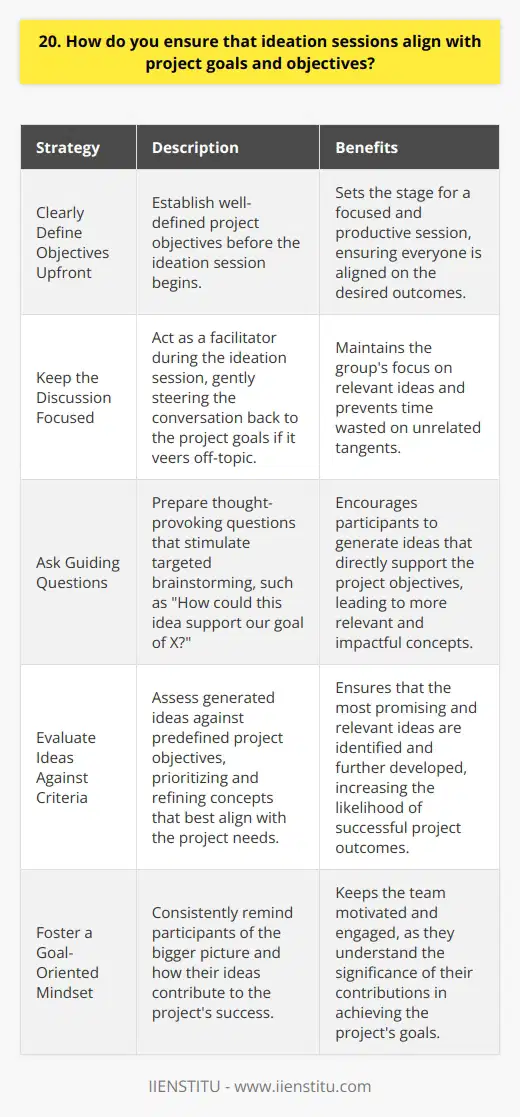
21. What are some ways to stimulate creative thinking before ideation sessions?
As someone who frequently participates in ideation sessions, I've discovered several effective ways to stimulate creative thinking beforehand:
Change Your Environment
I find that simply changing my physical surroundings can help spark new ideas. Take a walk outside, visit a museum, or work from a coffee shop for a fresh perspective.
Engage in Playful Activities
Before a brainstorming session, I like to engage in playful, creative activities. Building with Legos, sketching, or even playing improv games can get the creative juices flowing.
Embrace Constraints
Oddly enough, I've found that imposing constraints on my thinking can actually boost creativity. Try limiting yourself to a specific color palette, word count, or set of materials to encourage innovative problem-solving.
Consume Diverse Content
Exposing yourself to a wide range of content can help generate novel connections. I like to read articles or watch videos on topics outside my industry to gain fresh insights.
Collaborate with Others
Bouncing ideas off of others is a fantastic way to stimulate creative thinking. I always try to have a few casual conversations with colleagues or friends before ideation sessions.
The key is to approach ideation with an open, playful mindset. By trying these techniques, you'll be well-equipped to generate innovative ideas and solutions.
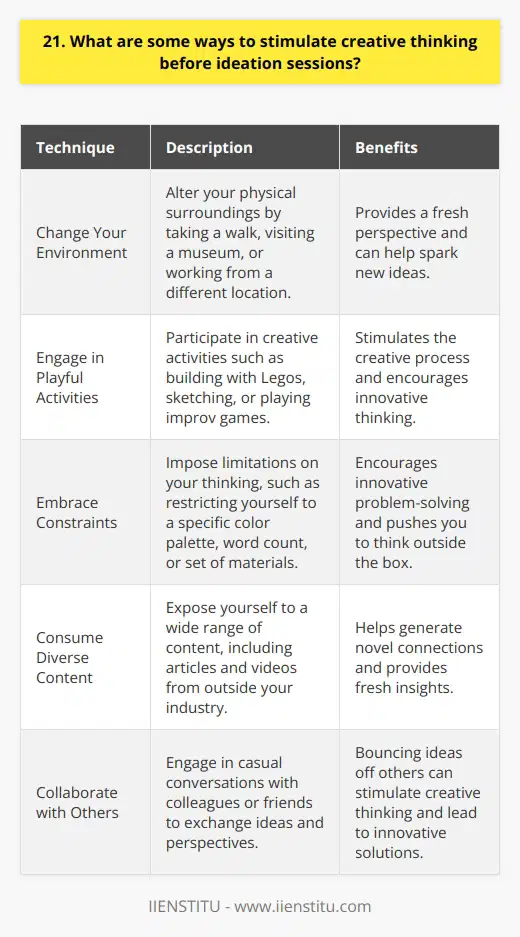
22. How can you encourage risk-taking and unconventional thinking during ideation?
To encourage risk-taking and unconventional thinking during ideation, I believe in creating a safe and supportive environment. When team members feel comfortable sharing their ideas without fear of judgment, they're more likely to think outside the box.
Lead by Example
I've found that when I share my own unconventional ideas, it inspires others to do the same. Even if my suggestions seem a bit crazy at first, they often spark creative discussions and lead to innovative solutions.
Embrace Failure
In my experience, the fear of failure is one of the biggest barriers to risk-taking. That's why I always emphasize that failure is a natural part of the ideation process. Every "failed" idea brings us one step closer to a breakthrough.
Encourage Diversity of Thought
I actively seek out team members with different backgrounds and perspectives. When we bring together people with diverse experiences and skillsets, it leads to a rich exchange of ideas and pushes us to think in new ways.
Celebrate Unconventional Ideas
Whenever someone shares an unconventional idea, I make a point to acknowledge and celebrate their creativity. Even if the idea doesn't end up being feasible, I believe in recognizing the courage it takes to think differently.
Ultimately, fostering a culture of risk-taking and unconventional thinking requires consistent effort and leadership. But when we create an environment where everyone feels empowered to share their wildest ideas, that's when true innovation happens.
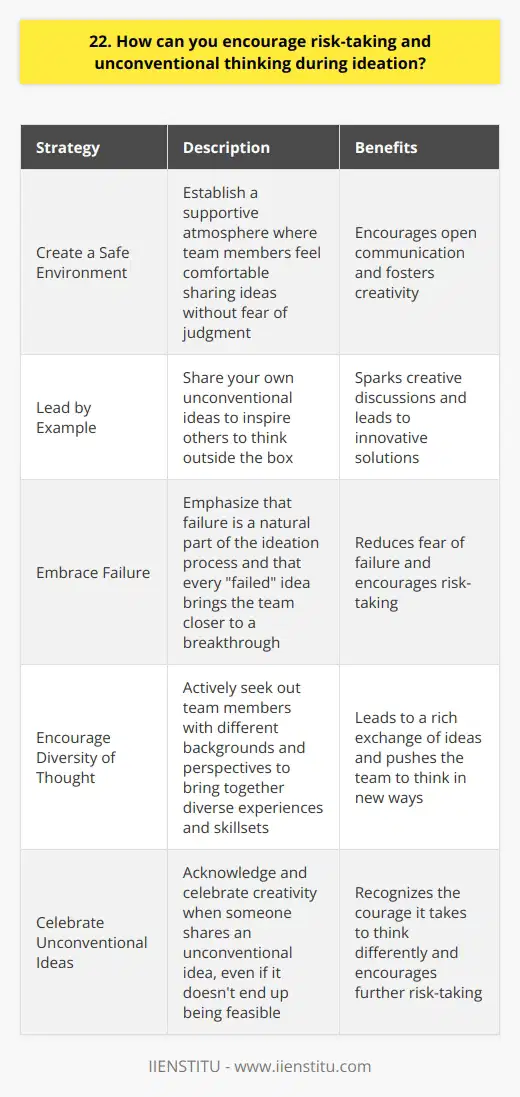
23. What are some techniques for generating ideas based on customer insights?
Generating ideas based on customer insights requires a deep understanding of your target audience. Here are some techniques I've found effective:
Conduct surveys and interviews
Directly asking customers for their thoughts and opinions can provide valuable insights. I once surveyed my customers about a new product idea and received great feedback that helped refine the concept.
Analyze customer data
Look at purchase histories, website analytics, and other data sources to identify patterns and trends. This helped me discover that many customers were interested in eco-friendly options, leading to a successful new product line.
Observe customers in action
Watch how customers interact with your products or services in real-world settings. I gained helpful insights by visiting stores and seeing how shoppers navigated the aisles and made purchase decisions.
Engage on social media
Monitor social media conversations and engage with customers there. I've found social platforms to be great places to learn about customer interests, pain points and gather candid feedback.
Collaborate with customer-facing teams
Your sales, support and service staff interact with customers daily. Regularly communicating with these teams can surface valuable customer insights and ideas you may have missed.
Stay curious!
Always be on the lookout for inspiration. Some of my best ideas have come from casual conversations with friends and family who fit my target customer profile. You never know where the next great insight will originate.

24. How do you maintain momentum and energy throughout the ideation process?
Maintaining momentum and energy throughout the ideation process is crucial for generating fresh, innovative ideas. I've found that taking regular breaks to recharge my mental batteries is essential. Even a quick 5-minute walk around the office can do wonders for my creativity and help me avoid burnout.
Collaboration is Key
I'm a big believer in the power of collaboration. Bouncing ideas off of colleagues and getting input from diverse perspectives always leads to more robust concepts. I love how a simple suggestion from a teammate can spark a whole new train of thought!
Embrace the Unconventional
To keep the ideas flowing, I try to approach problems from unexpected angles. Asking "what if" questions and considering seemingly unrelated concepts often leads to those "aha!" moments. It's all about staying open-minded and not being afraid to venture outside the box.
Fuel Your Inspiration
I find inspiration in all sorts of places - nature, art, conversations with friends. Exposing myself to new experiences and ideas helps me make unique connections that I can apply to the ideation process. Just last week, a trip to the local museum sparked an innovative solution to a design challenge I'd been grappling with.
Trust the Process
Finally, I've learned to trust the creative process, even when it feels messy or uncertain. Some of the best ideas emerge from the chaos of brainstorming. By staying patient, persistent, and passionate, I'm able to maintain the energy needed to see an idea through from conception to execution.
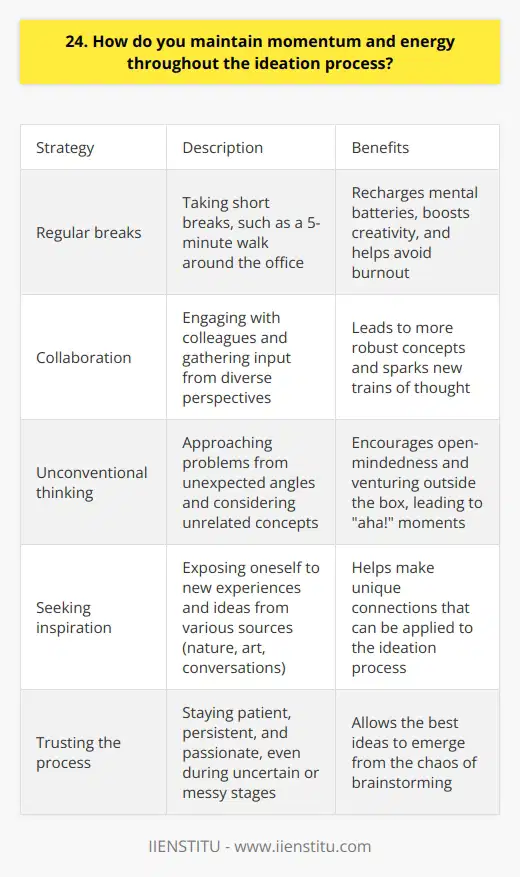
25. What are some strategies for overcoming groupthink during ideation?
<h3>Encouraging Diverse Perspectives</h3><h4>Actively seek out differing viewpoints</h4>In brainstorming sessions, I make a point to encourage input from quieter team members. I'll often go around the room and ask each person to share their perspective, even if it differs from the group consensus. Diverse opinions lead to more creative solutions. <h4>Assign a devil's advocate</h4>Another tactic I've found effective is assigning someone the role of devil's advocate - their job is to challenge the prevailing ideas and propose alternatives. This helps break groupthink by forcing the team to defend their position or modify it. It promotes healthy debate.<h3>Fostering Psychological Safety</h3><h4>Create an environment where dissent is welcome</h4>To get the best ideas, team members need to feel they can speak their mind without fear of reprisal. I set the tone as a leader that all viewpoints are valued. There are no bad ideas in brainstorming. I listen intently and praise people for contributing, especially when they voice a minority opinion. That way, everyone feels heard and groupthink is minimized.
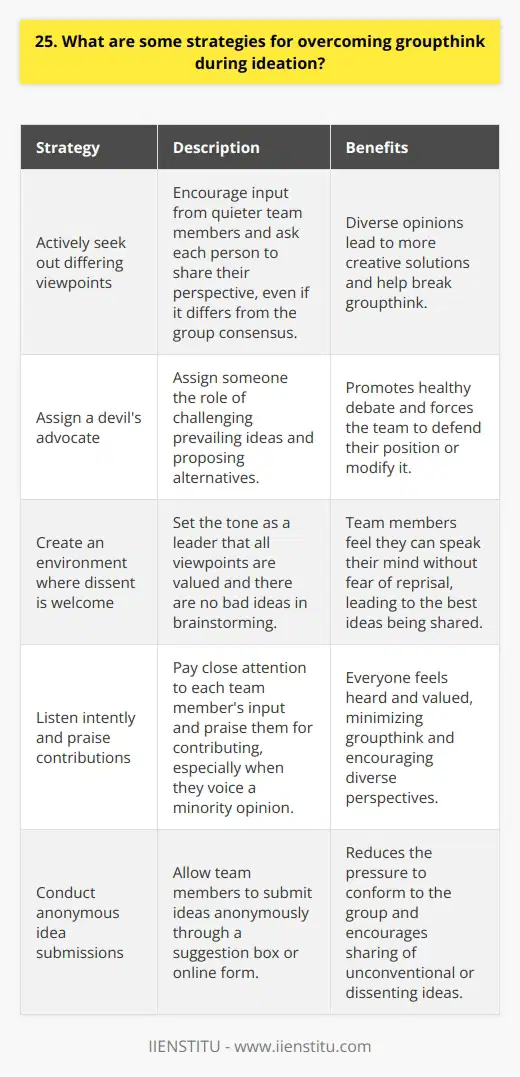
26. How can you create a culture of continuous ideation within an organization?
To create a culture of continuous ideation within an organization, I believe in empowering every team member. When employees feel valued and heard, they are more likely to share their innovative ideas openly.
Encourage Creativity and Risk-Taking
Leaders should foster an environment where creativity is celebrated and taking calculated risks is encouraged. In my experience, when people feel safe to think outside the box, groundbreaking ideas often emerge.
Establish Ideation Channels
Organizations need clear channels for employees to submit their ideas, such as regular brainstorming sessions or online platforms. I've seen the power of having a dedicated space for ideation firsthand.
Provide Resources and Support
Allocating resources, like time and funding, shows that the company is serious about turning promising ideas into reality. Offering support and guidance throughout the ideation process is crucial.
Recognize and Reward Innovation
Acknowledging and rewarding employees who contribute innovative ideas boosts morale and motivation. Even small gestures of appreciation can make a big impact, based on what I've witnessed in past roles.
Lead by Example
When leaders actively participate in ideation and champion innovative thinking, it sets the tone for the entire organization. I believe in the power of leading by example to create lasting change.
By implementing these strategies consistently, companies can cultivate a thriving culture of continuous ideation. It takes effort and commitment, but the payoff in terms of employee engagement and groundbreaking ideas is immense.
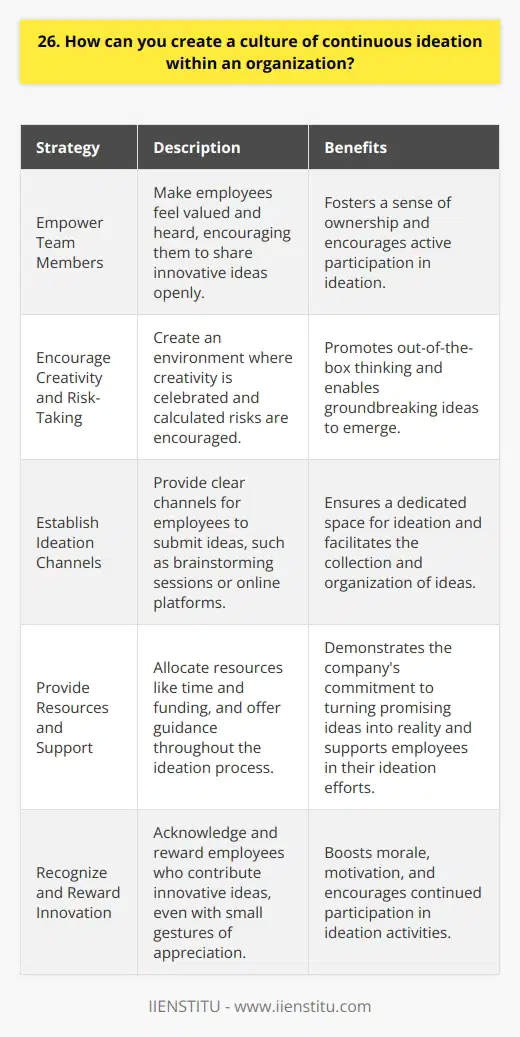
27. What are some methods for generating ideas based on market trends and insights?
Generating ideas based on market trends and insights is crucial for staying competitive and meeting customer needs. Here are some effective methods to consider:
Conduct thorough market research
I've found that diving deep into market data, customer feedback, and competitor analysis can spark innovative ideas. Last year, our team uncovered a significant shift in consumer preferences through surveys and focus groups, which led us to develop a successful new product line.
Engage in brainstorming sessions
Collaborating with colleagues from diverse backgrounds can lead to unique perspectives and fresh ideas. I always encourage open discussions where no idea is too wild – sometimes the most unconventional suggestions lead to breakthrough concepts!
Foster a culture of curiosity
Encouraging employees to stay curious about industry developments and customer needs can generate valuable insights. In my experience, regular lunch-and-learn sessions where team members share their findings have led to some of our most successful initiatives.
Leverage technology and data analytics
Harnessing the power of data analytics tools can reveal hidden patterns and opportunities. By analyzing customer behavior and market trends, we've been able to identify untapped niches and develop targeted solutions.
Seek inspiration from adjacent industries
Looking beyond your own industry can provide fresh perspectives and spark creative ideas. I've found that attending cross-industry conferences and engaging with professionals from diverse fields can lead to innovative solutions that can be adapted to our own market.
Ultimately, generating ideas based on market trends and insights requires a combination of research, collaboration, and openness to new perspectives. By staying attuned to customer needs and industry developments, we can drive innovation and stay ahead of the curve.
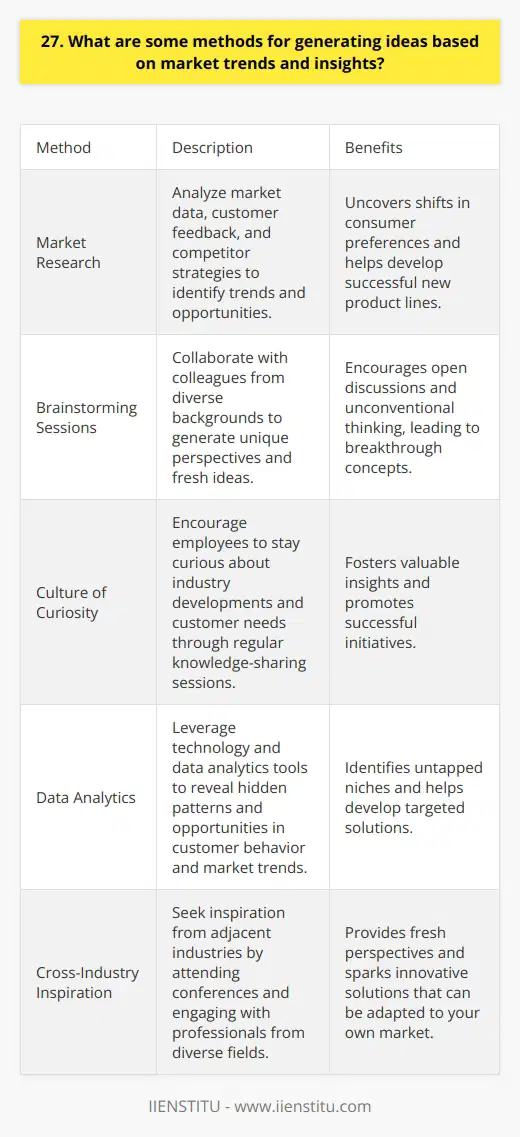
28. How do you balance structure and flexibility in the ideation process?
Balancing structure and flexibility in the ideation process is crucial for generating innovative solutions. I approach this by following a few key principles:
Set Clear Goals and Parameters
Before diving into brainstorming, I always clarify the objectives and constraints of the project. This provides a solid foundation while still allowing room for creativity.
Embrace Divergent Thinking
In the initial stages, I encourage wild ideas and out-of-the-box thinking. No concept is too crazy during this phase! I find that this open-minded approach often leads to the most innovative solutions.
Converge and Refine
After the freeform ideation, I begin narrowing down the ideas based on feasibility and alignment with goals. This is where structure comes into play, as I systematically evaluate and refine the most promising concepts.
Stay Agile and Adaptable
Throughout the process, I remain open to pivots and course corrections. If a new insight emerges or circumstances change, I'm always ready to adjust my approach. Flexibility is key to arriving at the best solution.
In my experience, the most successful ideation strikes a balance between structured exploration and flexible thinking. By setting clear goals, thinking broadly, refining strategically, and staying adaptable, I'm able to consistently generate creative yet practical ideas.
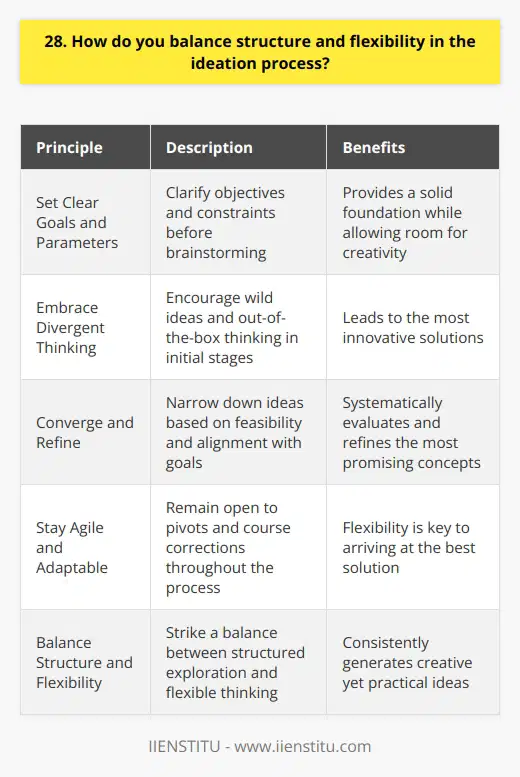
29. What are some techniques for generating ideas that challenge industry norms?
Generating ideas that challenge industry norms requires a combination of creativity, curiosity, and strategic thinking. Here are some techniques I've found effective:
Embrace an Outsider's Perspective
Sometimes the best insights come from those unfamiliar with the industry. Seek out diverse viewpoints and consider how someone from a different field might approach the problem. This can lead to unexpected solutions.
Question Everything
Don't accept "that's how it's always been done" as an answer. Ask why current practices exist and whether they truly serve the end goal. By challenging assumptions, you open the door to innovation.
Combine Unlikely Elements
Look for opportunities to mix and match ideas from different domains. What if you applied principles from nature to engineering or combined insights from psychology with software design? Novel combinations spark groundbreaking concepts.
Envision the Ideal Future State
Imagine the perfect solution without constraints. What would it look like in an ideal world? Work backwards from there to identify incremental steps to make that vision a reality. Dreaming big frees you from limitations.
Observe and Listen to Customers
Spend time understanding the unmet needs and frustrations of your target audience. Their pain points often reveal opportunities for disruptive ideas. Immerse yourself in their world to gain empathy and fresh perspectives.
The key is staying curious, thinking laterally, and not being afraid to propose unconventional approaches. With practice, generating norm-defying ideas becomes second nature.
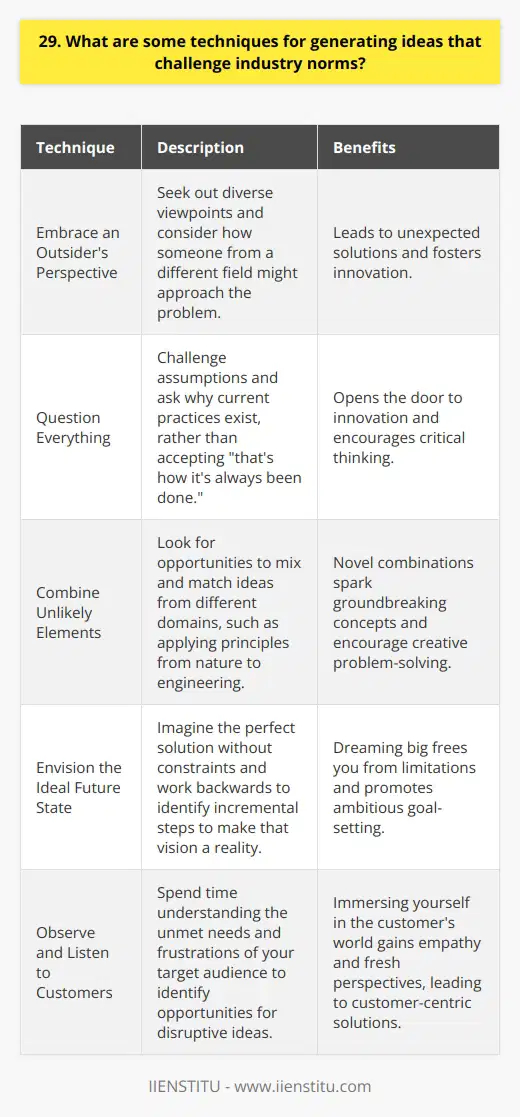
30. How can you measure the success and impact of ideation efforts?
Measuring the success and impact of ideation efforts is crucial for driving innovation and continuous improvement. Here are some key strategies I've found effective:
Set Clear Objectives and KPIs
Before starting any ideation initiative, establish specific, measurable goals aligned with your overall business strategy. Define key performance indicators (KPIs) to track progress, such as the number of ideas generated, the percentage of ideas implemented, or the revenue impact of new products or services.
Engage Diverse Perspectives
Involve a cross-functional team in the ideation process to capture diverse viewpoints. Encourage participation from different departments, levels, and backgrounds. This diversity of thought can lead to more innovative and impactful ideas.
Implement a Structured Evaluation Process
Develop a systematic approach to evaluate and prioritize ideas based on predefined criteria, such as feasibility, market potential, and alignment with strategic objectives. Use a scoring system or matrix to objectively assess each idea's merits and potential impact.
Monitor Implementation and Outcomes
Track the progress of selected ideas through the implementation phase. Monitor key metrics, such as time-to-market, customer adoption, and financial performance. Regularly review and analyze these outcomes to determine the success and impact of your ideation efforts.
In my experience, one of the most powerful ways to measure ideation success is through customer feedback. Engage with your target audience, gather their insights, and assess how well your new offerings meet their needs and expectations. Their satisfaction and loyalty are ultimate indicators of your ideation impact.
Remember, measuring ideation success is an ongoing process. Continuously refine your evaluation methods, adapt to changing market dynamics, and celebrate the lessons learned from both successes and failures. By staying committed to data-driven decision-making and continuous improvement, you can maximize the impact of your ideation efforts and drive long-term business growth.
